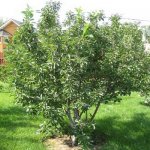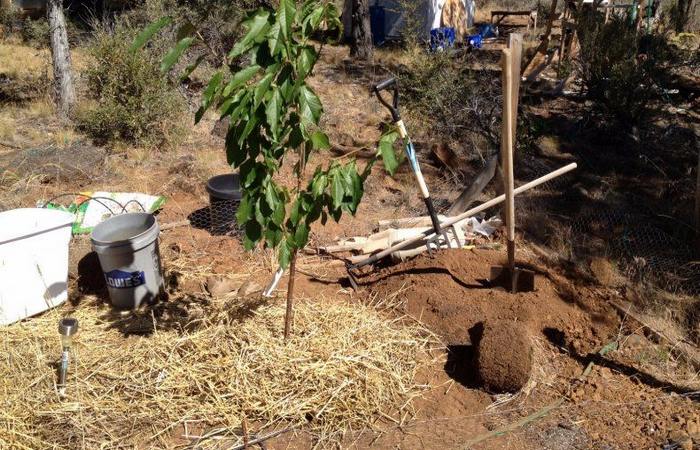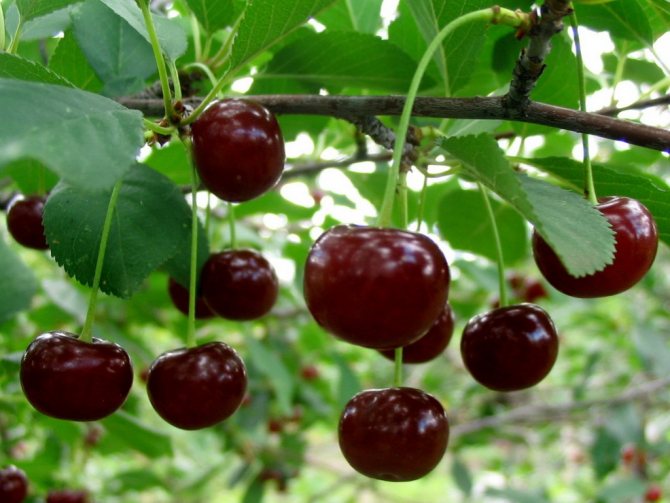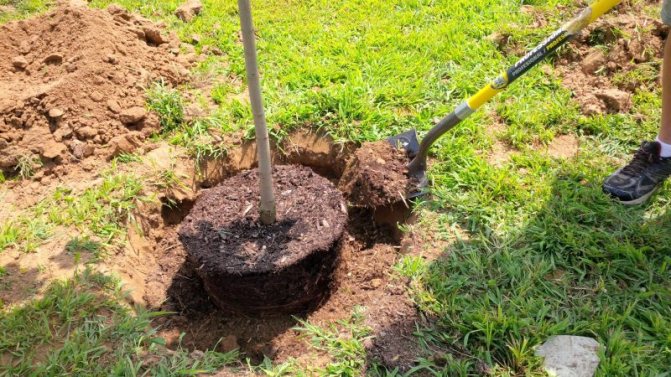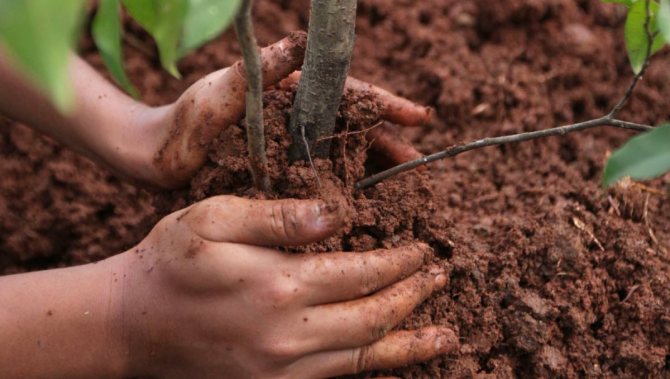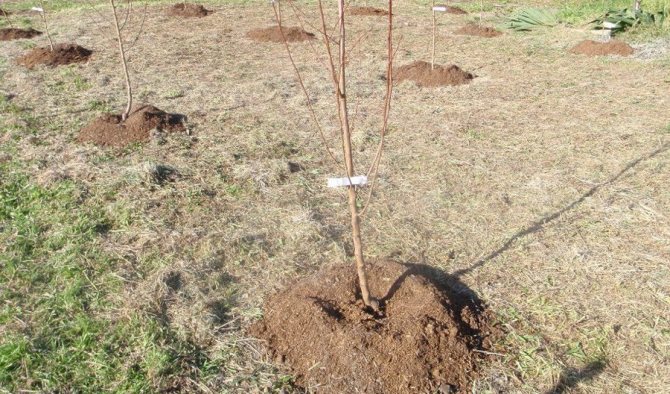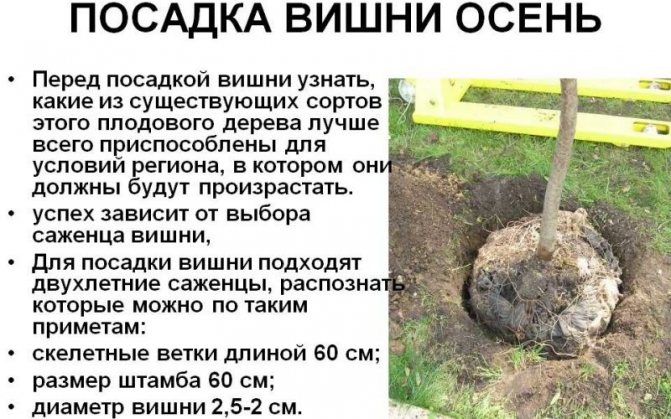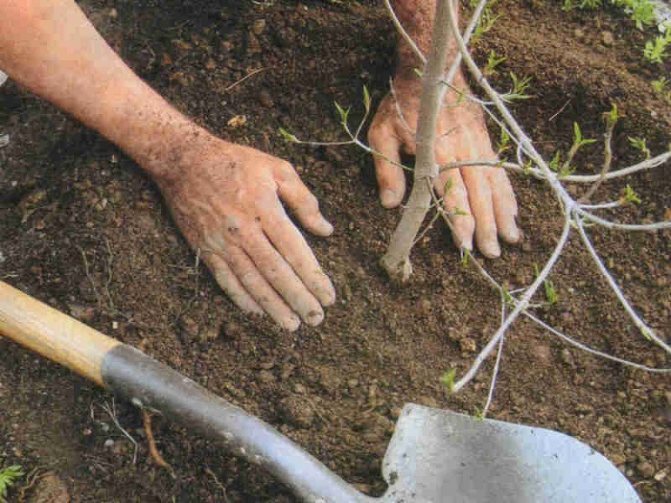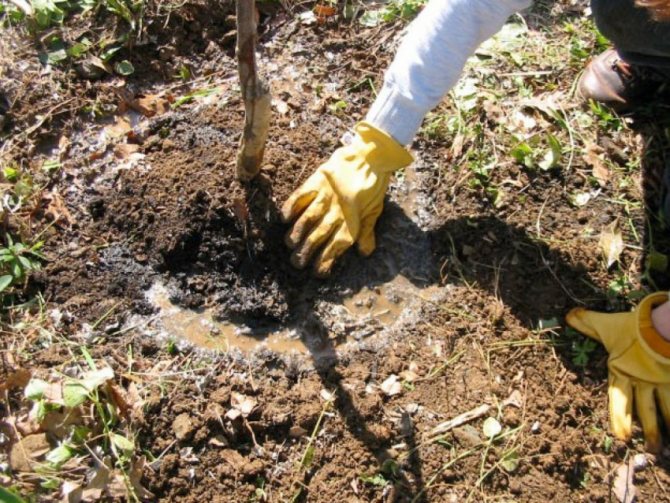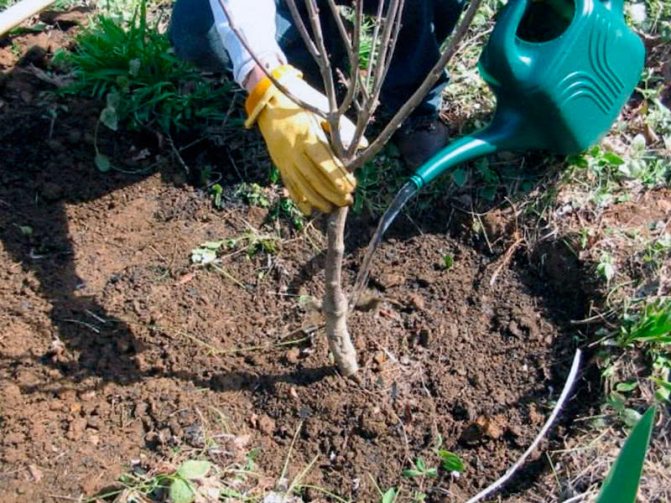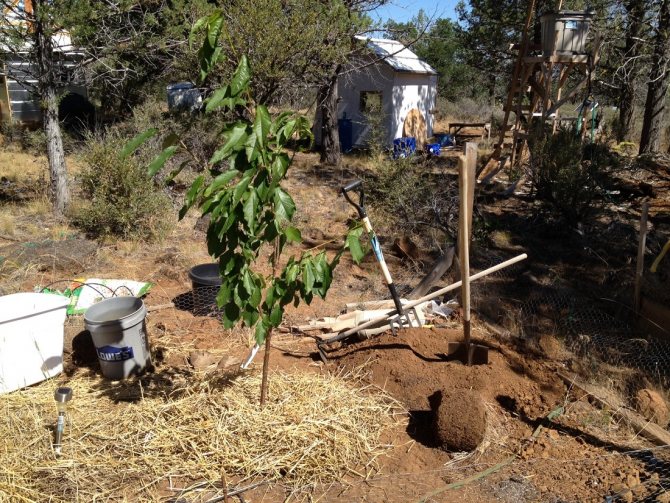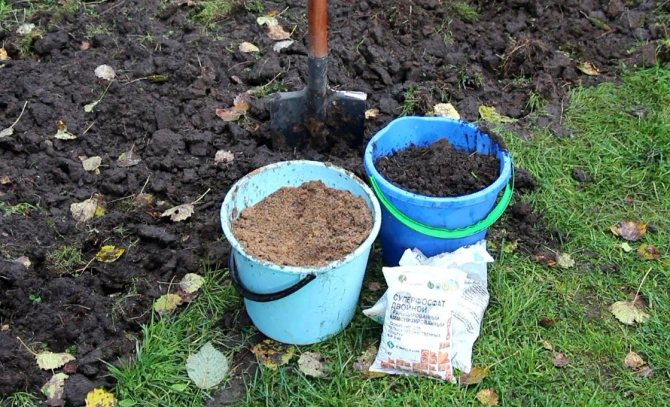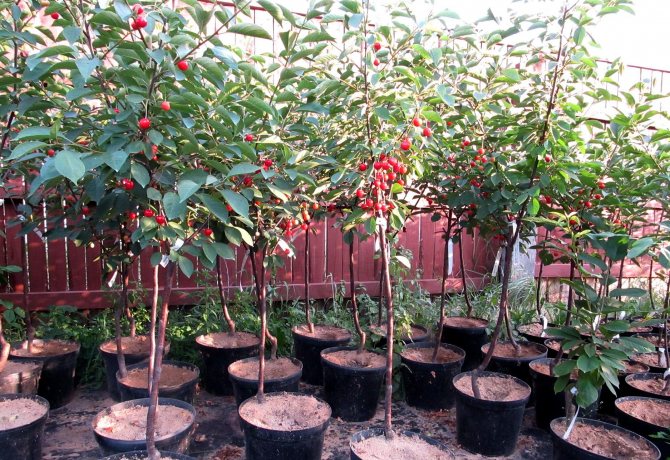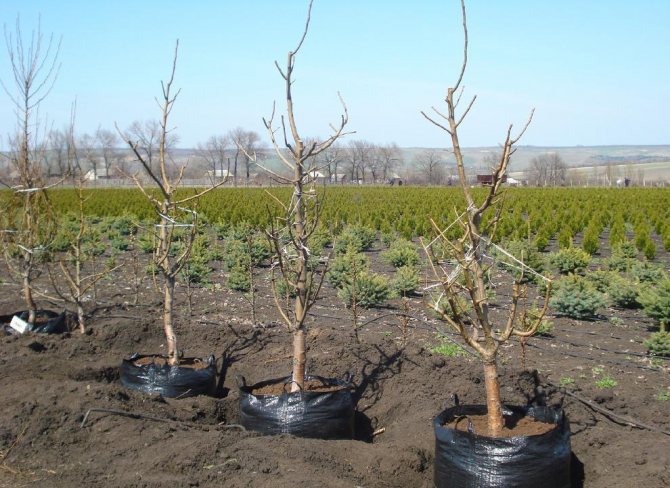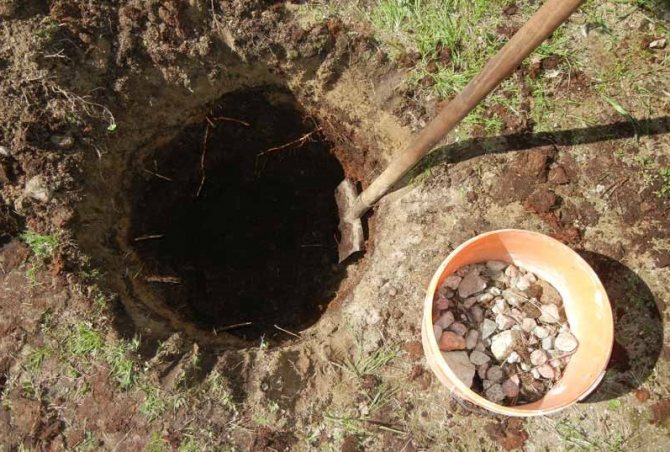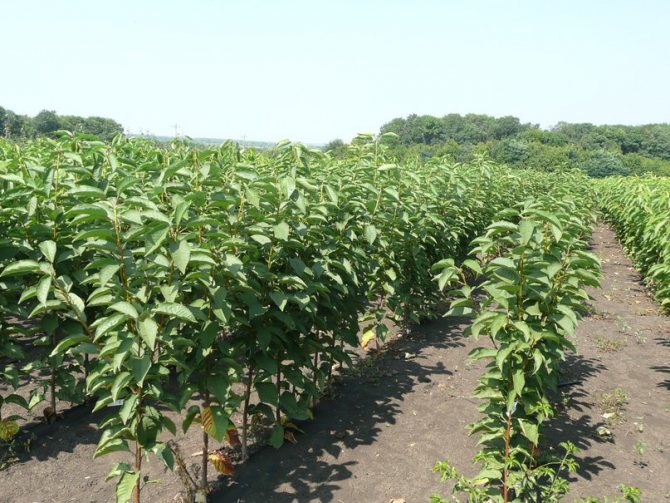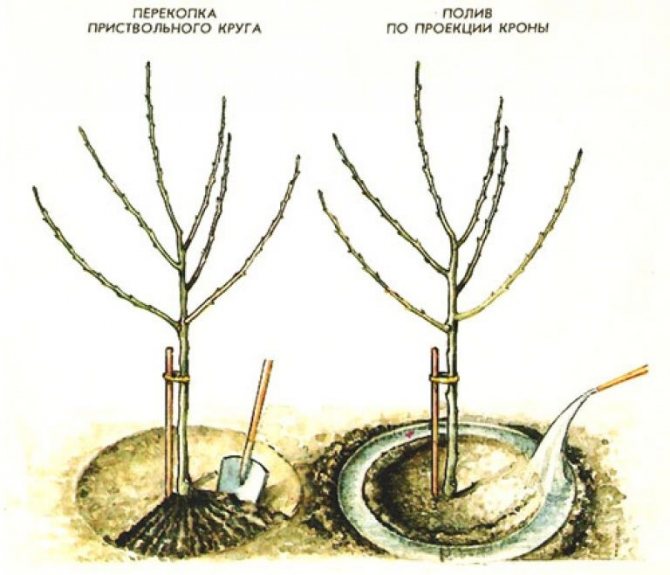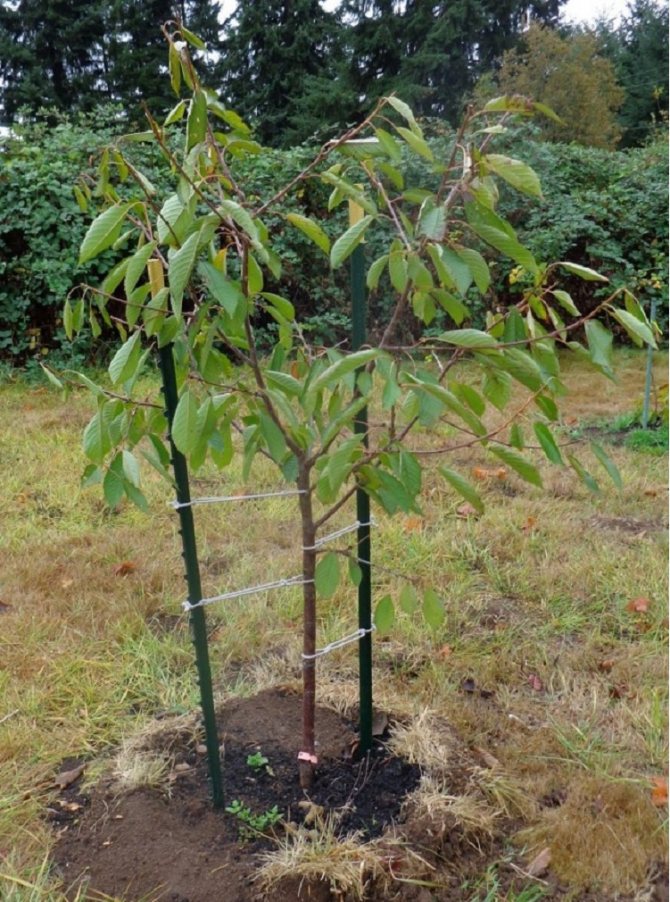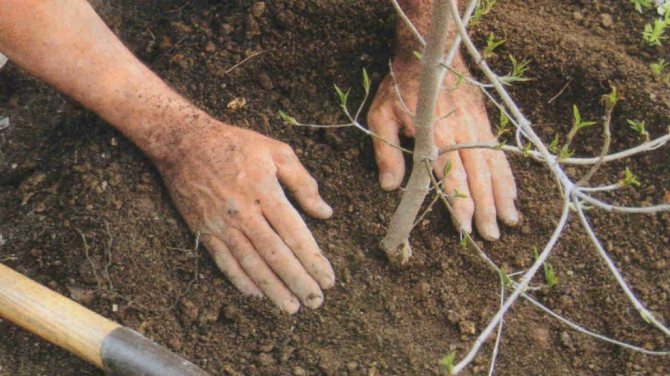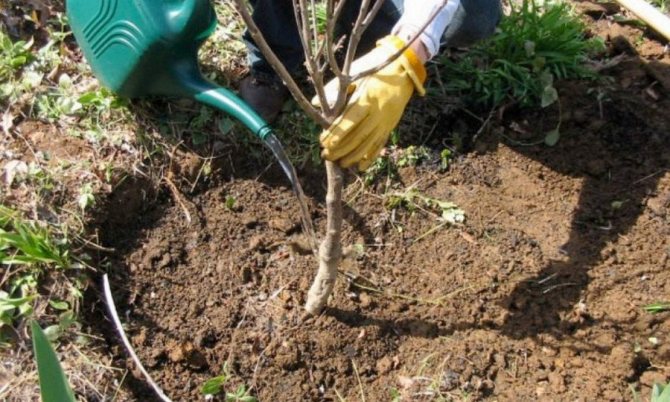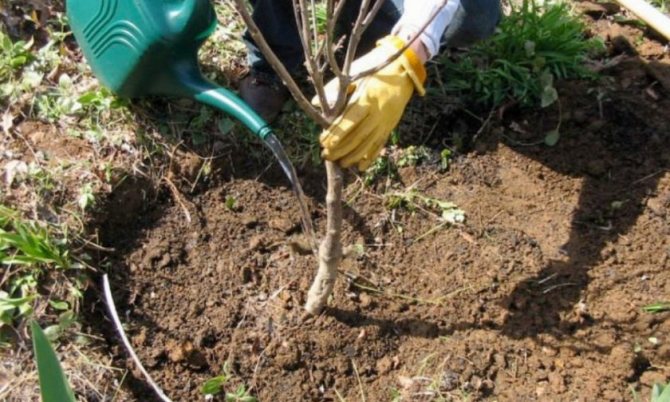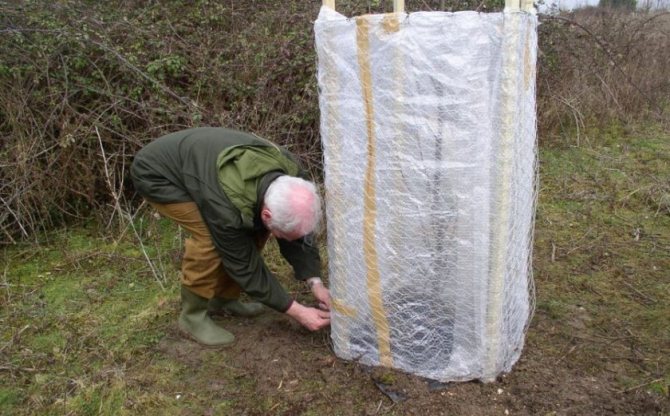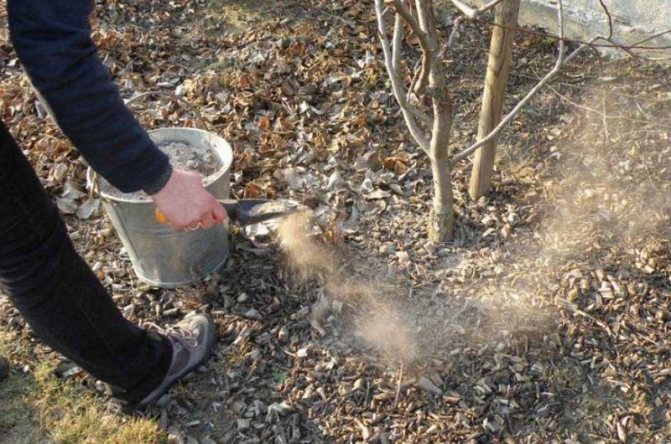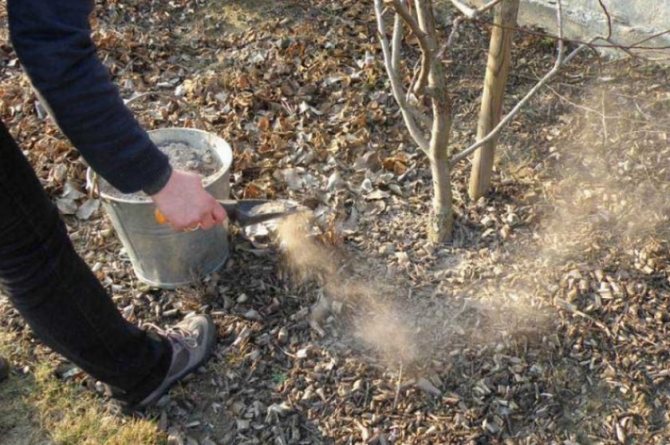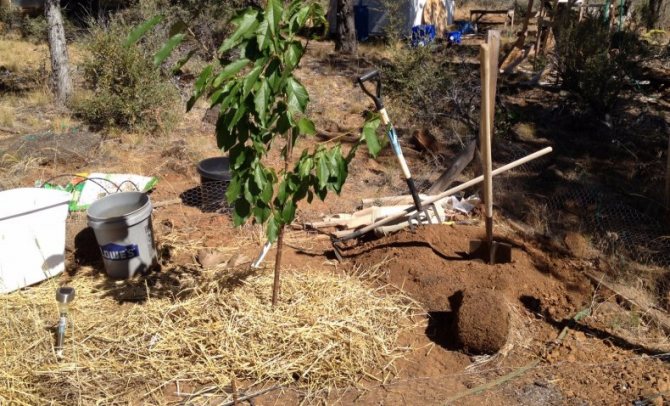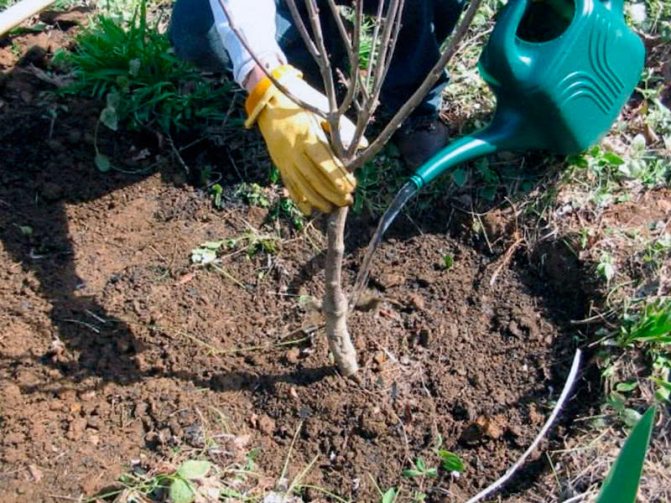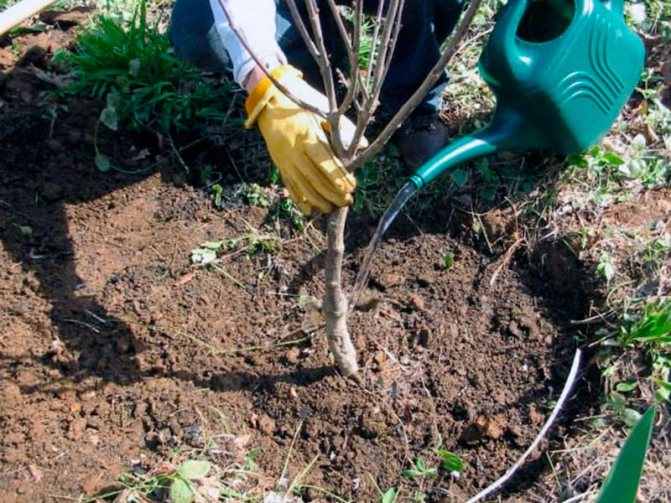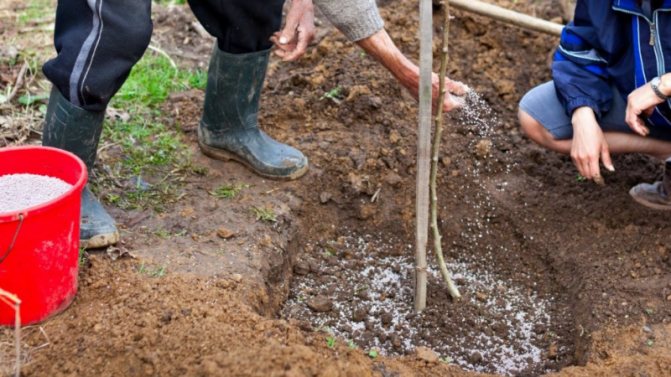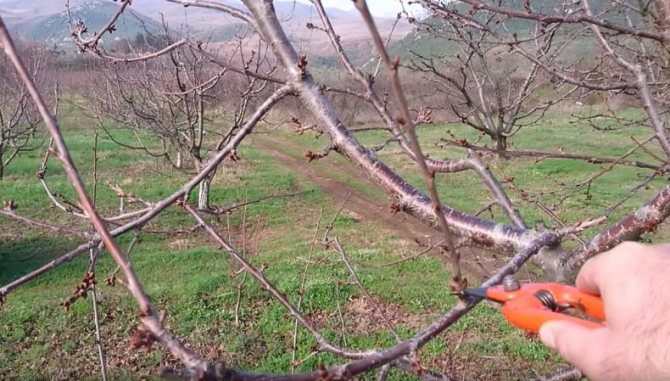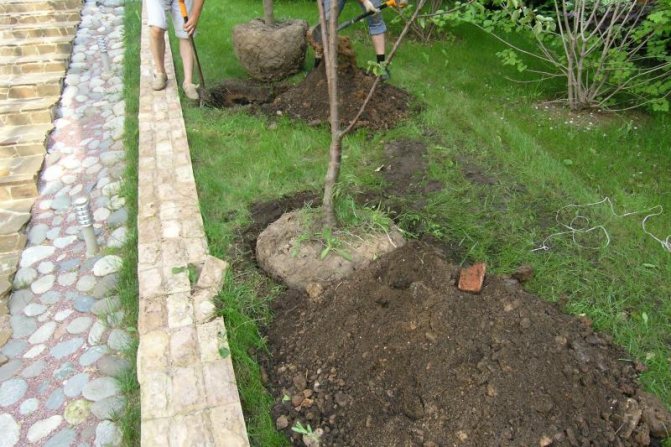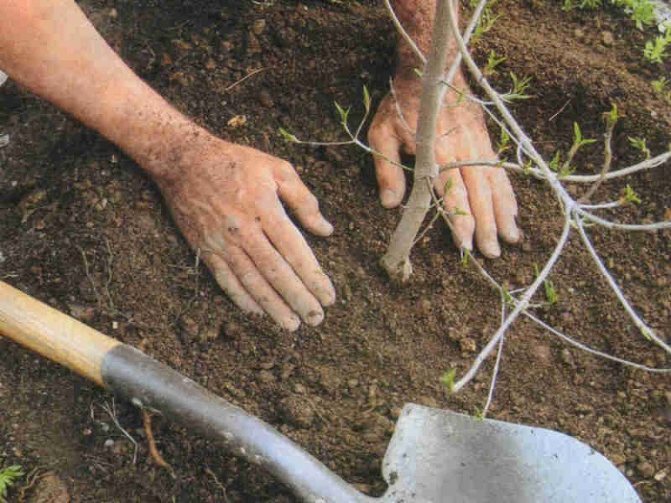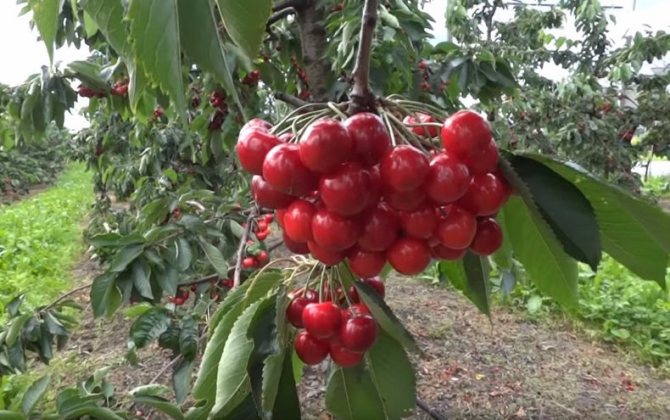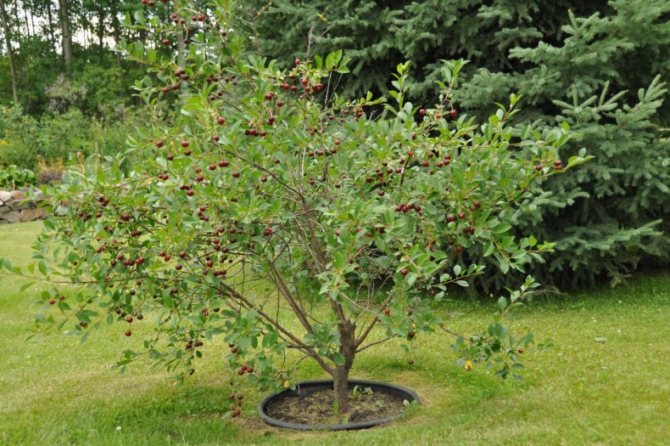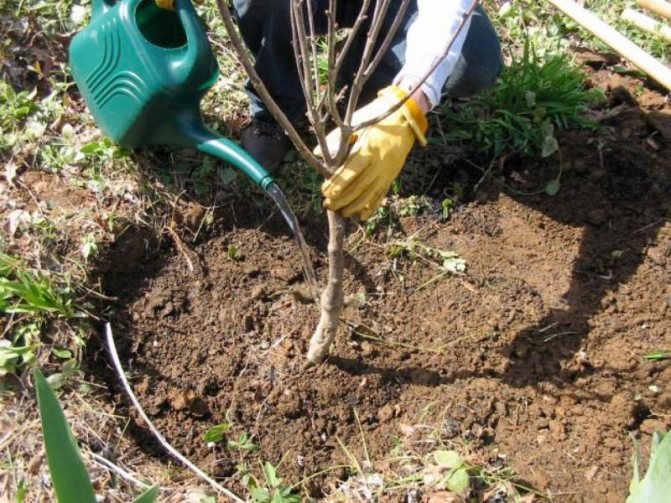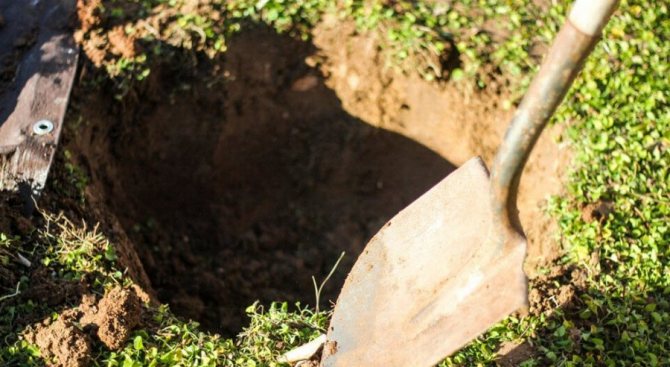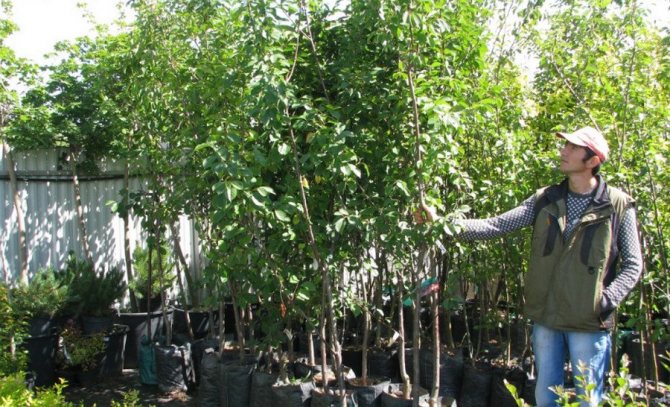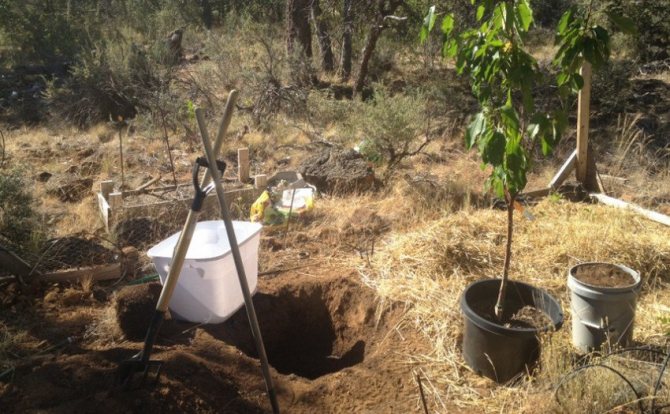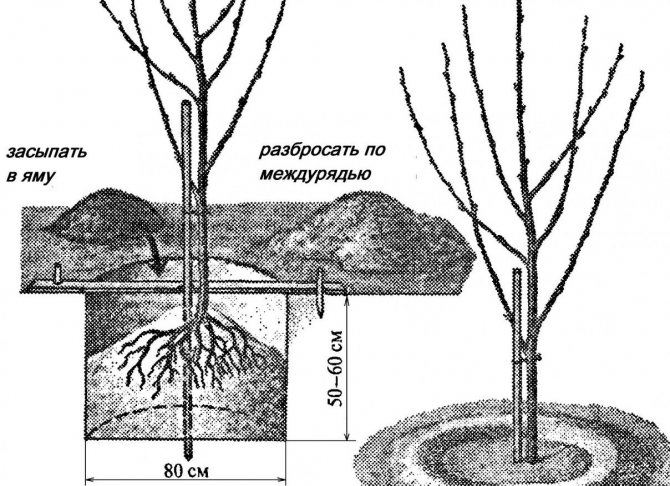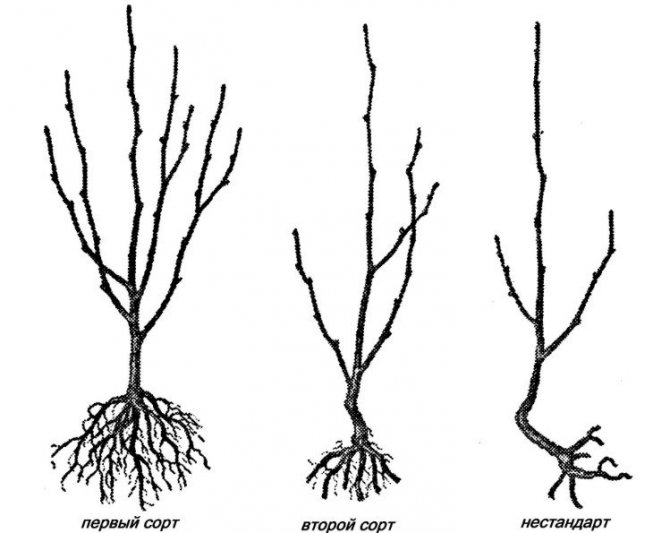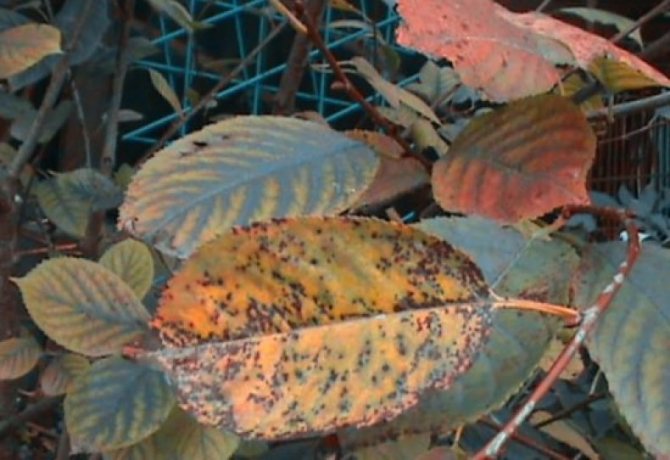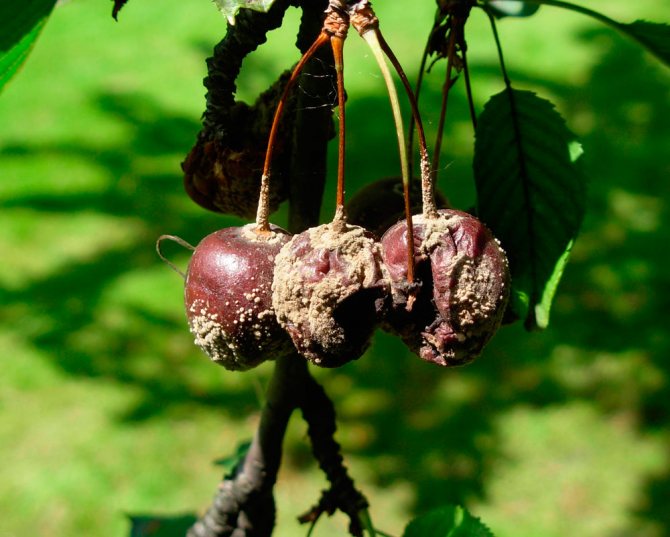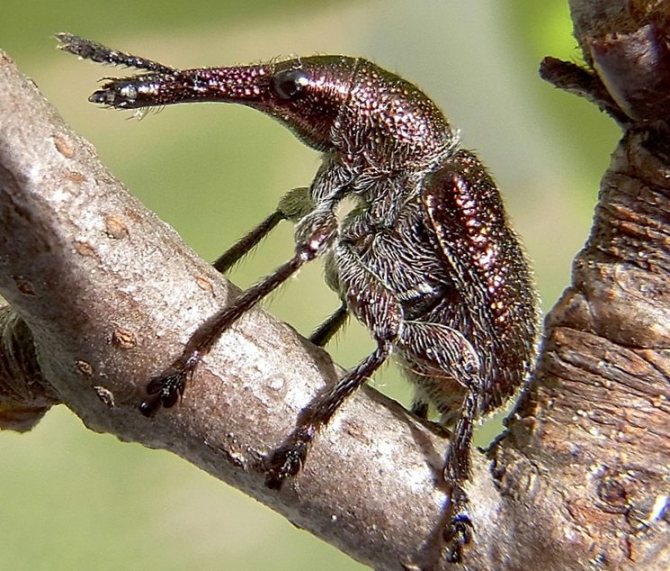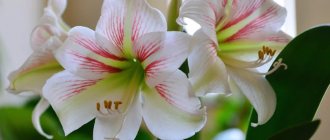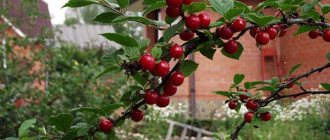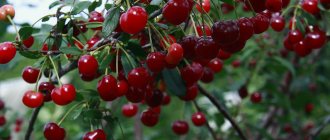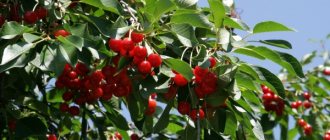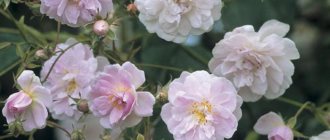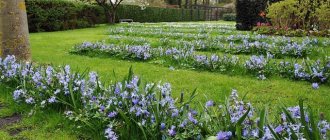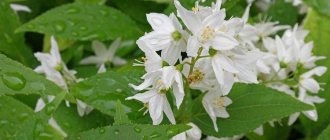Features of autumn planting
Most gardeners prefer to plant seedlings in the spring, but there are circumstances in which fall planting is much more efficient and safer. Seedlings planted in autumn have more rooting time compared to spring planting.
Why is it better to plant cherry seedlings in the fall:
- Lack of risks typical for spring planting. In spring, the seedling is exposed to the complex effects of adverse factors - it can be attacked by recurrent frosts, and also suffers from sudden temperature changes.
- Minimal impact of negative natural factors. If the seedling is planted correctly, then a period with optimal temperature conditions awaits it. During the time remaining before frost, the trees have time to take root.
- High-quality healing of wounds received during planting. Sapling, pruned, just before planting. During the rest period, which lasts until spring, all wounds will heal.
- Trees planted in spring are ahead of development. In "autumn" seedlings, the root system has time to develop well, and when spring comes, the tree begins to rapidly build up its vegetative mass.
- The planting material is of better quality than in the spring. In nurseries, seedlings are dug up in the fall, and those that do not sell right away are stored until spring. Saplings bought in spring are inferior in strength and vitality to autumn ones. Although they were stored correctly, they still underwent stress that disrupted their natural development.
- It is easy to determine the health of the seedling by the fresh root system.
- Fall planting is easier than spring planting. It is enough to plant a tree and cover it - you don't have to do anything else. Watering, weeding, fungicide treatment, feeding - all these are spring events.
The main condition for autumn planting is that a month and a half should remain before the onset of persistent cold weather.
Risks when planting seedlings in autumn:
- Possibility of freezing of the roots and the whole tree during severe winter frosts.
- In winter, the seedlings are threatened by icing, heavy snowfalls and squally winds.
- Damage to the bark by rodents.
Pros of an autumn transplant
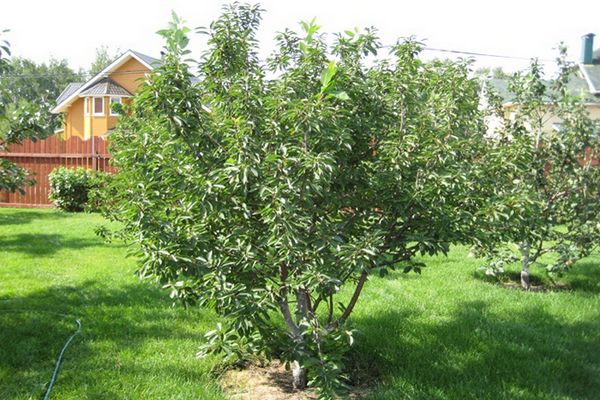
Gardeners transplant plantings twice a year: in spring and autumn, however, an autumn transplant is preferable to a spring one, and for the following reasons:
- adaptation goes better, in a shorter time;
- the root system takes root quickly;
- in spring, the tree will begin to grow actively;
- life expectancy increases;
- fruiting is long and abundant;
- during the winter, the cherry's immunity will rise, and the likelihood of contracting infections and diseases will be minimal.
Despite the listed advantages, you need to remember that any transplant for cherries is stress, so you need to properly prepare for the process: choose the right time, follow the technology and subsequently care for the culture.
Recommended timing
The timing of planting cherry seedlings is selected taking into account:
- features of the local climate;
- average temperatures in the region;
- long-term observations of the nature of the autumn weather.
Knowing, or rather, assuming the possible date of the onset of frost, 20, or better 30 days are counted from it - this is the optimal planting time.
Optimum temperatures for the seedling:
- daytime - from +10 to +15 ° С;
- night - from 0 to +2 ° С.
A contraindication to autumn planting is the late acquisition of seedlings - if they do not have time to take root, they will either die or become weakened, low-yielding trees in the future. If you cannot meet the deadline, it is better to dig the seedlings in the ground - until spring.
Terms and features of planting cherries in different regions
The timing of the autumn planting of cherries is adjusted to the climatic conditions of the regions. Gardeners, first of all, take into account the time of arrival of the first frosts and persistent cold weather.
The approximate timing of planting cherry seedlings, depending on the region
| Region | Optimal timing of autumn planting | Note |
| Middle lane and Moscow region | from early to mid-October | The seedlings are planted when the temperature is favorable for quick adaptation and establishment. |
| Southern regions | from mid-October to mid-November | The plant, after leaving the dormant period, gets into conditions that are optimal for adaptation. |
| Northern regions and the Urals | beginning of September | Frosts come early here, it is important to have time to plant seedlings on time. |
In regions with severe winters - in the north of Russia, in Siberia, in the Urals, it is advisable to plant cherries in the spring.
We recommend reading the article about popular varieties of cherries for growing in the Moscow region.
Landing requirements
Cherries can hardly transfer transplanting from place to place. They are demanding on soils, lighting and other conditions. Before starting work, the gardener carefully selects a place where the tree will feel comfortable. Under favorable circumstances, cherries bear fruit for 15-25 years.
Pick-up location
When choosing a site for planting cherries, they take into account, first of all, illumination and protection from the wind. Characteristics of a plot suitable for planting cherry seedlings:
- Good sunshine. Lack of shade from adjacent landings. The best option is a gentle southern or southwestern slope. The sun should illuminate the tree from morning to afternoon - at least, and better - until the evening.
- The presence of a barrier nearby, such as a fence. The barrier should be located on the north side to protect the tree from cold winds. Otherwise, the risk of freezing of flowers increases.
Conditions unsuitable for cherries:
- close occurrence of groundwater - less than 1.5 m;
- waterlogged and swampy lowlands;
- acidic peat bogs;
- close proximity of oak, linden, spruce, birch, pine, apple, tobacco, raspberry.
The soil
It is not recommended to plant cherries on low-quality, low-nutrient and waste soils. Before planting a seedling, the top fertile soil layer is carefully developed - its thickness should be at least 20 cm.
Cherry grows best and bears fruit on black soil, sandy loam and loam, which have a neutral reaction. But before preparing the soil for planting, they will find out what conditions a particular cherry variety requires.
Features of soil preparation for planting cherries:
- Acidic peaty soils are definitely not suitable - you have to replace the entire top fertile layer.
- To neutralize the acidity of the soil, dolomite flour or wood ash is added to it.
- Weeds interfere with the root system of cherries, therefore, before planting, the soil is carefully dug up - and more than once, and during the digging, the roots of weeds are selected from the ground.
- Digging up the site, they add compost, manure or mineral fertilizers. Manure / compost is applied 8-10 kg per 1 sq. m, superphosphate - 60 g, potassium chloride - 30 g.
Suitable place and soil preparation
It is undesirable to transplant cherries: it reacts poorly to the procedure. Therefore, the choice of a place for it must be approached responsibly, trying to immediately take into account how much it grows over time, whether other trees and walls of buildings will interfere with it. The culture prefers loose, well-drained soil.Cherries will be most comfortable in light or medium loamy, sandy or sandy loam soil with a neutral reaction. They do not tolerate acidic soil.
Suitable for them are areas open to the sun, but sheltered from the wind, located in the west, south-west or south side of the garden. In such conditions, trees grow more actively, and berries ripen on their branches faster. When deciding on a place for planting cherries, it is important to take into account its botanical features. Trees bloom early, when the threat of frost has not yet passed. Cherry protection from winds is especially necessary in the winter-spring period. It affects the longevity, health and productivity of plants. Combined with wind, frost can damage trees more. When the cherries bloom, currents of cold air will interfere with pollination, drying out the pistils and making it difficult for the bees to work.
In lowlands, where it is damp and windy, and in areas with swampy soil, crop cultivation will not be successful. It is advisable to plant cherries on gentle slopes, near fences or buildings. In winter, they will trap snow, protecting trees from freezing. Cherries will not benefit from the proximity of groundwater. Their minimum depth at the landing site should be 1.5 m.
The soil for the cherries is prepared in advance. If the procedure is carried out in the spring, the soil is treated in the fall, digging up and enriching it with fertilizers. Organic and mineral compositions are suitable for culture.
For planting, the following components must be brought in (per 1 m²):
- up to 15 kg of manure (compost);
- 100 g of phosphorus fertilizers (superphosphate, phosphate rock);
- 100 g of potassium preparations (potassium sulfate, potassium chloride, potassium salt).
Preparatory activities
When the site is selected and prepared, they proceed to the next stage - the preparation of seedlings and holes for planting.
Selection and preparation of a seedling
Cherry varieties are often self-fertile, so in order for the trees to fully bear fruit, they acquire at least three seedlings of different varieties. A combined planting of self-fertile cherries is also recommended - it increases the yield of trees at times.
Before choosing a seedling, you need to familiarize yourself with the best varieties of cherries. You can read about popular varieties here.
The rules for choosing seedlings:
- The seedlings must be healthy, without damaging the bark and root system.
- The best seedlings are one-year-olds with a height of 0.7-0.8 m or two-year-olds with a height of 1.1-1.2 m.
- Developed root system - from 25 cm in length.
- A height of more than 1.2 m indicates an overfeeding of the plant with nitrogen - such seedlings have reduced winter hardiness. It is better not to plant such trees before winter - they will die.
- Own-rooted seedlings are considered more winter-hardy. It is better to plant grafted seedlings in spring.
Preparatory manipulations
Planting cherries in autumn requires special preparatory work. The list of manipulations includes:
- digging a planting hole;
- applying the necessary fertilizers;
- compliance with the rules, techniques;
- optimal time.
Fruit trees are difficult to tolerate transplanting, so it is recommended to initially choose a suitable place for planting seedlings. The transplant can be carried out in the spring, so that the plant has time to adapt over the summer.
Planting cherries in the fall will be effective if done in October.
Before planting, appropriate preparatory work is carried out with the soil, seedlings. As for the climate, it does not play a secondary role. Local weather conditions must be taken into account when choosing a cherry variety. Planting cherry seedlings in the middle lane is carried out only in warm weather. It can be done in early October. Thus, the plant will have time to get stronger by winter.
Use mineral, organic fertilizers. Cherries cannot be planted in acidic soil, they must be neutral. The planting pit is prepared a month before the planting process.It is advisable to choose a place near the fence so that the seedlings are protected from gusty winds.
A simple liming of the soil can be done to eliminate excess acidity. It is not necessary to cultivate the entire territory; you can apply fertilizer and other means into a depression next to the root system. The planting pit has the appropriate dimensions, it is important not to damage the roots. The diameter is 60 centimeters and the depth is 30 cm.
Landing technology
Step-by-step instructions for planting a cherry seedling:
- Submerge a stake approximately 2 m long into the pit. Position it closer to the north side.
- From the soil mixture, form a mound in the hole.
- Lower the seedling into the hole, spreading the roots evenly over the tubercle.
- Cover the roots with the rest of the soil and compact it. Form a near-trunk circle by drawing a side along its edge.
- Pour warm water over the seedling - 2-3 buckets are enough.
The seedling is deepened to the optimum depth, which is determined by the location of the root collar. The latter should be 3-5 cm from the surface of the earth. When the earth settles, the root collar will be at the level of the soil. If, after watering and settling the soil, the neck is not in place, it is corrected.
If you deeply deepen the root system of the seedling, it will develop poorly. If the roots are too close to the surface, they risk freezing out in winter.
How to plant cherries
Early planting is recommended. They begin to it when the snow melts, and the soil dries out a little and warms up, choosing a warm, dry and calm day for the procedure. Before placing in the ground, the roots of the seedling must be carefully examined. Damaged areas are carefully trimmed to healthy tissue. Dried roots are reanimated by immersing them in water for 3-4 hours. You can use a solution of a drug that stimulates root growth.
The planting hole is prepared in advance, at least 2 weeks in advance, and preferably in the fall. It should be of medium depth (50-60 cm) and wide (80 cm). Shallow planting will cause the roots of the tree to overheat in summer and freeze in winter. But if you deepen the cherry too much, the development of its root system will be difficult. A support is installed in the center of the hole - a wooden stake 1 m high.
Digging a hole, the top layer of soil is set aside. It will need to be mixed with fertilizers:
- humus;
- wood ash;
- phosphorus-potassium preparations;
- complex formulations.
The resulting soil mixture is poured into the pit so that a mound forms around the support. Having dipped the lower part of the seedling into a mash made of soil or clay with manure, it is placed on top of the northern side of the stake and, carefully spreading the roots, covered with earth. It is necessary to ensure that the trunk of the tree is strictly perpendicular to the ground surface. If everything is done correctly, its root collar should remain above the soil - 4-5 cm above it.
The soil around the seedling is well compacted and forms a hole. Then the tree is watered abundantly, bringing about 3 buckets of water under it. It should be warm, room temperature. After watering, the soil will settle, and the root collar of the plant will be at the same level with it. The trunk is tied to a support so that it does not break from the wind. The surface of the hole is mulched. You can use for this:
- dry ground;
- humus;
- peat;
- sawdust.
The thickness of the mulch should be 3-5 cm. Its layer will not allow the soil crust to form and will keep the soil moist longer.
Planting patterns for different varieties of cherries
The cherry planting scheme depends on the type of plant, its height and crown spreading. Usually cherries are not planted alone - pollinating cherries are located nearby. The first thing a gardener has to decide is at what distance from each other to plant seedlings.
Recommended planting schemes for cherry seedlings (distance between trees x distance between rows):
- bush cherries - 2x2 m;
- undersized tree cherries - 2x3 m.
- tall tree cherries - 3x3 m or 3.5x3.5 m.
To obtain good yields, it is recommended to plant 2-3 varieties at the same time, blooming at the same time - so that mutual pollination occurs. The optimal arrangement of seedlings is staggered.
Planting pit formation, soil preparation
Planting pits are prepared in advanceat least 15 days in advance. The recommended arrangement for bushy varieties is 2x2, for tree varieties 3.5x3.5. The optimal pit size is 50x50x50.
You also need in advance prepare soil mixture for filling the pit... To do this, use the top layer of soil, deposited after digging a hole. It is mixed with nutrients:
- humus 1 bucket;
- potassium sulfate (30 g);
- superphosphate 200 g
The heavy soil is structured by adding 2 buckets of river sand. A drainage layer of expanded clay is laid at the bottom of the pit and 1/3 of the pit is covered with prepared soil, well compacted.
Also it must be remembered that nitrogen is found in large quantities in chicken manure and pig manure.
Care after landing
The process of autumn planting itself does not represent anything complicated, and you can not remember about leaving until spring. After the autumn planting, gardeners have only one agrotechnical measure left to carry out - the warming of the seedling.
In order for the seedling to winter safely, it is protected from frost, snowstorms and rodents. Procedure:
- Watering the tree. The norm is 5 liters. When the cold comes, the near-trunk hole is filled up so that melt water does not stagnate in it in winter.
- Immediately before the very frosts - a month and a half after planting, the seedling is huddled, raking up an additional layer of soil of 30-35 cm. Even better is to mulch the soil with sawdust, humus or peat.
- From above, they are additionally covered with spruce branches, reeds or other breathable material. The created protection will save the seedling from both cold and damping off. In the spring, the protective layer is removed and the soil is leveled near the base of the tree.
All other activities for the care of the seedling are postponed to spring. With the onset of heat, the tree is cut, watered, treated with fungicides, loosened.
How to dig in seedlings
This scheme is not complicated. It is necessary to choose the area in the garden in which the snow lies the longest. Dig a hole, its depth should be at least 30 centimeters. The seedling is laid at an angle, the root is sprinkled with earth. Then abundant watering is carried out. This will allow the soil to stick to the roots and retain the moisture it needs. After the seedling is dug in, it must be prepared for wintering. To do this, it is covered with needles and sawdust from wood. So the seedlings will be additionally protected from various rodents.
What mistakes are made when planting cherries?
Not a single gardener is immune from mistakes. Given the variety of landing techniques and the abundance of nuances, it is not difficult to get confused. The most common mistakes:
- Purchase of large seedlings. If you follow the lead of such aspirations, you run the risk of getting a problem tree. The larger the seedling, the older it is and the more difficult it is to take root. You cannot buy a seedling older than two years.
- Purchase of planting material for future use. Do not take seedlings in advance. If the tree does not enter the dormant period and does not prepare for the upcoming wintering, it will root poorly.
- Digging the site shortly before planting. It is advisable to do this event in advance. Ideally, in the spring. The pit is prepared no later than 2 weeks in advance - if this rule is violated, the root collar will be buried in the soil due to soil subsidence.
- Overdose when fertilizing the planting pit. With an excess of mineral elements, bacteria die, processing fertilizers into forms accessible to plants.
- Use of fresh manure... The decomposition of not rotted manure in the soil is accompanied by the release of carbon dioxide and ammonia, which suppress the root system of plants.
There is nothing difficult in the autumn planting of cherries - the main thing is to study the agricultural technology of measures and correctly determine their timing. If you approach the matter correctly, then the autumn planting will bear fruit - the seedling will safely take root and quickly grow into growth in the spring.
There is no consensus on when it is best to plant cherries: some gardeners prefer to plant in the spring, while others find more benefits in the fall procedure. It seems to us that everyone should decide for themselves when to plant cherries - in spring or autumn, and we will provide you with information that will help you make the right choice.
Where can I plant a tree: selection and preparation of the site
Mature cherries do not tolerate transplanting very well. Therefore, you need to choose a site for growing a fruit tree, taking into account the life expectancy.
With proper care and favorable conditions bush cherry lives up to 18 years, tree up to 25 years.
Cherry grows well on loam and sandy loam with a neutral alkaline reaction. It is important to take into account the occurrence of groundwater, it should not be higher than 1.5 meters.
An acidic peaty soil is not suitable for a fruit tree. Therefore, it will be necessary to replace the top layer by at least 20 cm.
Cherry roots do not compete well with weeds, therefore, you need to dig up the site several times, carefully removing the remains of other plants.
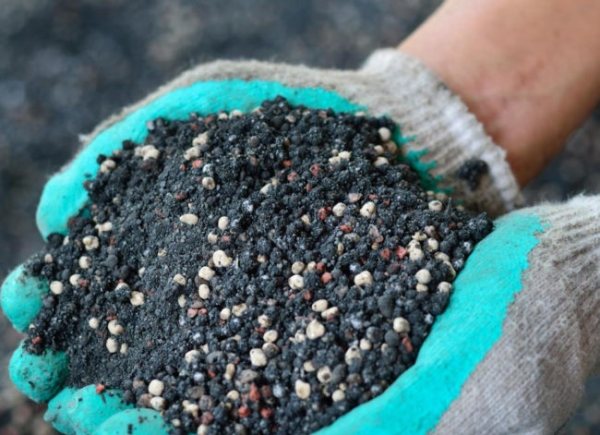

Before planting cherries, you need to dig up the area several times, fertilize with superphosphate, compost or manure
Wherein at the rate of 1 m2 in the ground, you need to make:
- compost or manure 8-10 kg;
- superphosphate 60 g;
- potassium chloride 30 g.
When landing in lowlandswhere stagnation of moisture and cold air is constantly formed, or in areas constantly blown by the wind, the tree develops poorly.
Cherry suffers from bark and root collapse, freezing of flower ovaries, gum flow and desiccation of branches. This creates a favorable environment for the formation of dangerous diseases, therefore, cherries must be looked after.
How to plant cherries in the fall
Selection of seedlings for planting
One-year-old saplings with a height of about 70-80 cm or two-year-old trees reaching 110-120 cm in height take root better. Their root system should be well-formed and fibrous, and the wood should be ripe. If you are offered two-year-old seedlings with a height of one and a half meters, refuse to buy: this planting material is most likely overfed with nitrogen, which means that the seedlings have low winter hardiness and are not suitable for autumn planting.
Since most of the cherry varieties are self-fertile, at least three cherries of different varieties should be planted in the area in close proximity to each other. Self-fertile varieties are Shokoladnitsa, Nord Star, Vstrecha and Lyubskaya - these cherries do not need partners for pollination and the formation of an ovary, but even self-fertile varieties bear fruit better in the vicinity of other cherry trees.
Cherry seedlings are self-rooted and grafted. Grafted seedlings begin to bear fruit earlier, and self-rooted seedlings are easier to propagate, and they are more winter-hardy: if suddenly the entire ground part of own-rooted cherry dies in severe frosts, the plant can be restored from its own root growth. And frozen grafted cherries cannot be restored.
Site selection and preparation
Cherry is very difficult to endure a transplant, so choose a place for it responsibly, with the expectation that it will grow in this area from 15 to 25 years. The site should be well lit by the sun and protected from the wind. The most suitable for growing cherries is a mild southern or southwestern slope. Do not plant cherries in low-lying areas, where melt and rain water can accumulate or fog and cold air can stagnate. Groundwater should lie in an area not higher than 1.5 m.
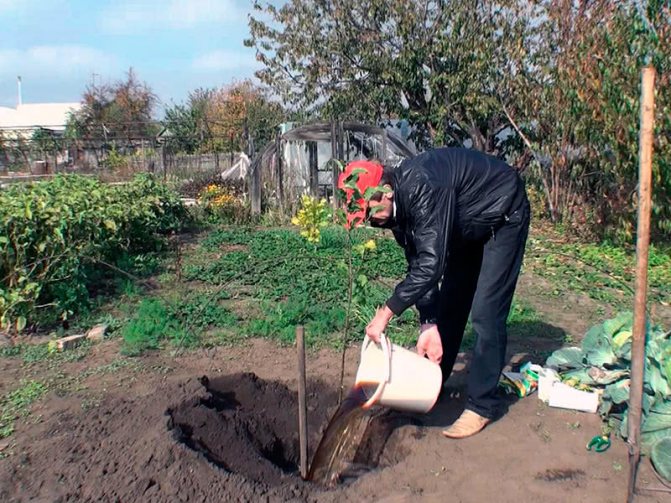

The optimal soil for cherries is light fertile loam or well-fertilized neutral sandy loam (pH = 7.0).The tree grows on other soils, but peaty acidic soils are categorically not suitable for it.
You need to prepare a site for autumn planting in the spring. Dig the ground to the depth of a shovel bayonet, remove all weeds, apply 8-10 kg of compost or humus and 150-200 g of complex mineral fertilizer for each m². Two weeks before planting, prepare pits measuring 50x50x50 cm at a distance of 2 m from each other for bush varieties and at a distance of 3.5 m for tree cherries. Put a bucket of humus, 200 g of superphosphate and 500 g of wood ash in each pit and mix the ingredients well. If the soil in the area is heavy, you can add 1-2 buckets of sand to the nutrient mixture.
Planting cherries in autumn
Before planting, the roots of the seedlings are straightened, cut too long and then dipped the root system in a mash of water, manure and clay - the consistency of the composition should be like a store sour cream. Then, at the northern wall of the pit, a long peg is driven in, the upper end of which should protrude half a meter above the surface, and an earthen mound is poured onto the bottom of the pit so that the root collar of the seedling installed on it is 3-5 cm above the surface level of the site.
The roots of the seedling are straightened, the pit is filled with earth, compacted, a hole is made around the seedling so that the water does not spread during watering, but flows to the roots, and 1.5-2 buckets of water are poured under the cherry. After the water has been absorbed and the soil has settled, and the root collar of the seedling drops to ground level, tie the seedling to a peg. Just do not confuse the root collar on the grafted seedling. with the vaccination site, which is usually 5-7 cm above the neck.
When is it better to plant cherries - in spring or autumn
Cherry is an unpretentious plant, thanks to which it is successfully grown not only in the southern regions of Russia, but also in places with a more severe climate. To achieve good development of the seedling and in the future - a rich harvest, you need to comply with the planting dates.
Cherries grown in a container, that is, having a closed root system, can be planted throughout the spring and summer, but no later than a month before the onset of frost.
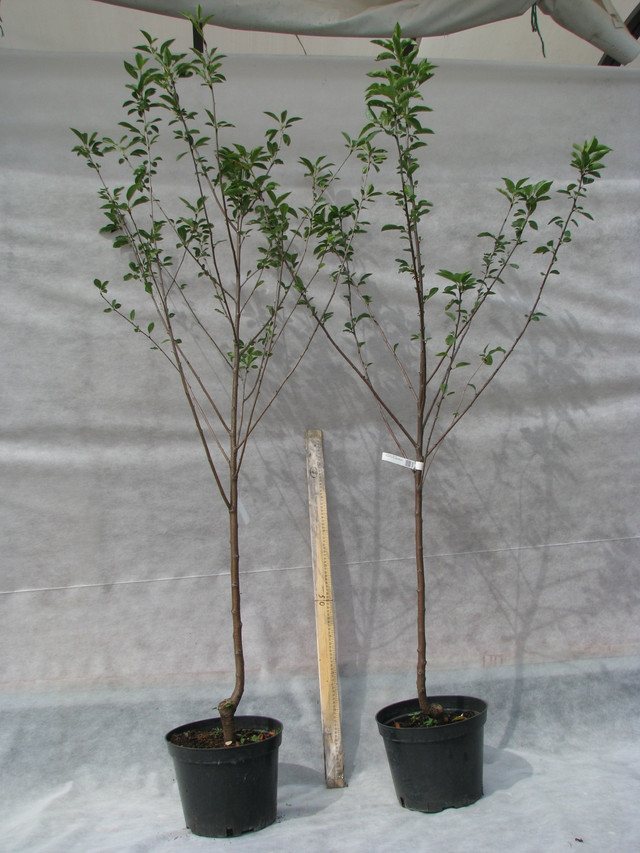

Cherry seedlings with a closed root system are planted throughout the summer
Landing dates in different regions
For seedlings with an open root system, the planting time is determined by the climatic zone.
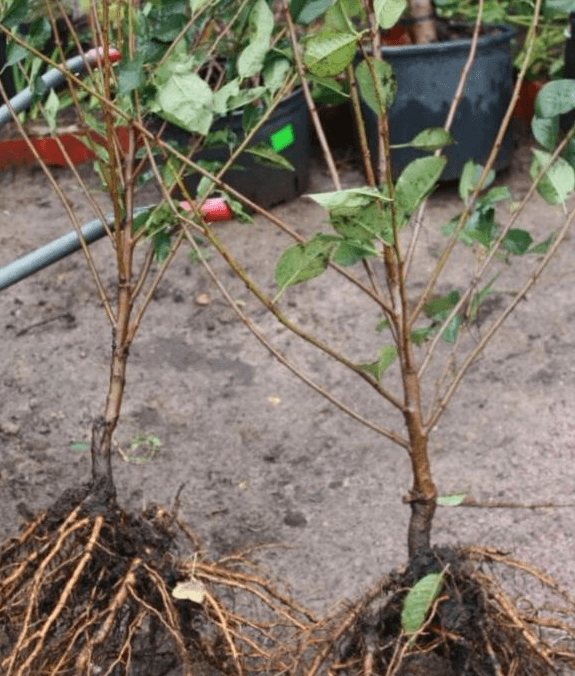

Cherry seedlings with an open root system are planted taking into account the climate of the region
In the south of our country, cherries can be planted both in spring and autumn, while in the central zone of Russia, in the north-west, in the Leningrad region, in the Urals and in Siberia, it is advisable to do this in the spring.
Spring planting of cherries
The best time to plant cherries in spring is the first half of April.
In warmer regions this will be the beginning of the month, in colder regions it will be closer to the end. It is important to hold this event before bud break and when the earth warms up. A plant planted at the optimal time will take root better and be more resistant to various weather conditions. Healthy and well-rooted seedlings are less affected by diseases and pests.
Cherry is a thermophilic plant, so you need to start planting by choosing a place - the sunniest part of the garden. The occurrence of groundwater should be no closer than 1.5 m from the soil surface. When planting several seedlings, you need to leave a distance of 3.5 m between the holes so that the overgrown bushes do not interfere with each other.
When planting cherries in a row, it is necessary to leave a distance of at least 3 m between the seedlings
First, prepare the landing pit. It is advisable to do this in the fall or at least 2 weeks before planting:
- Dig a hole, taking into account the size of the root system of the seedling and the quality of the soil, but, as a rule, it is 60x60 cm.
- Fill the hole with a nutrient mixture - garden soil with the addition of rotted manure or compost in a ratio of 2/1.
- Add phosphorus-potassium fertilizers or ash to the bottom so that the roots do not come into contact with them during planting. This can cause burns.It is important to take into account that cherries do not tolerate acidic soils, therefore, if the acidity of the soil is increased, liming should be carried out before preparing the pit.
Stages of planting cherries:
- Remove part of the ground from the prepared pit. When planting a seedling, the pit is prepared in advance.
- Drive a wooden peg into the center.
- Place the seedling so that the root collar is at ground level. The root collar of the seedling should be above ground level
- Cover the root system with prepared soil. After installing the seedling in the planting hole, it is covered with earth.
- Lightly compact the soil and water it well. The ground around the seedling needs to be tamped
- Tie the seedling to the peg with a knitted cord or twine.
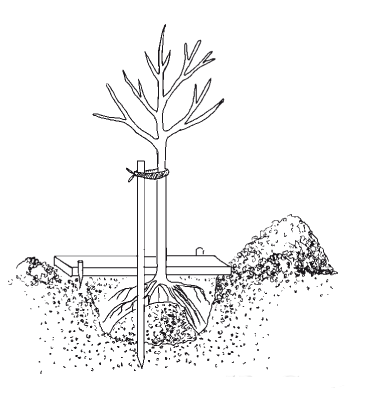

The seedling must be tied to a support - Mulch the near-trunk circle with peat or rotted manure.
Video: planting cherries in spring
Planting cherries in autumn
In areas with a temperate or warm climate, autumn planting of cherries is preferable.
The seedlings planted in early October have time to take root and tolerate the winter well.
Before boarding, you must:
- Remove all leaves so that the plant does not consume moisture.
- Examine the root system, remove rotten roots.
- If the roots are slightly dry, place the seedling in water for 3 hours.
- Dip the roots in a chatterbox - an aqueous solution of clay and manure, taken in equal parts.
The rest of the planting is no different from the spring one.
Autumn ditch of cherries
It often happens that gardeners wanted to buy a certain cherry variety, but could not find it in the spring. The fall assortment is usually richer, although the time for planting is risky in many regions. Do not refuse to buy, fearing that the young plant will freeze. Cherry seedlings purchased in the fall can be dug in before winter:
- Dig a trench from west to east about half a meter deep.
- Make the southern slope, where the tops of the seedlings will be laid, inclined.
- Place the seedlings in the trench.
- Sprinkle the roots and part of the trunk with earth, about 1/3.
- Water well.
- So that in winter the seedlings do not damage the mice, you can spread out rags soaked in tar or turpentine and cover the hole with spruce branches.
A properly dug cherry seedling will easily withstand even the most severe frosts
If the winter turns out to be little snow, it will be necessary to rake snow to the dug-in seedlings, forming a small snowdrift. Such a measure will help young plants to survive even the harshest weather.
In the spring, after the snow melts, the seedlings can be dug up, and in April they can be planted in a permanent place.
Cherry care after planting
With the onset of cold weather, the surface around the trunk of the seedling is leveled so that in the spring melt water does not stagnate in the hole, the lower part of the trunk is spud with dry soil to a height of 30-35 cm, and the seedling itself is covered with spruce branches. As soon as the snow falls, hide the seedling under a snowdrift: under such a shelter, the tree will not be afraid of any frosts.
Cherry is a tree that is distinguished by a variety of varieties. In total, there are more than 150 different species. Despite this, gardeners prefer steppe and felt cherries. Both species have taken root well in the Middle Lane - for example, the steppe variety can often be seen in the Moscow region. They are also successfully grown in the Urals and Siberia. These are the most resistant varieties of cherry trees. Most often, cherries are planted in the fall: a lot depends on when and how to plant a tree so that it takes root and bears fruit from year to year.
Spring planting dates for cherries
It is generally accepted that the best time for planting fruit and berry crops is spring. Cherry is no exception. In spring, all plants are actively growing processes, both in the underground and in the aboveground parts. New roots grow, young shoots are formed. And nature itself actively helps in this. There is still enough moisture in the soil after the snow has melted, it is warm outside, but not hot, plus precipitation ... In general, planting in the spring is not only possible, but also necessary.
However, it should be borne in mind that in different regions, spring comes in different ways. In the south, it is warm already in March, but in the middle lane - not earlier than mid-April. Accordingly, the timing of planting cherry seedlings should correspond to these months.
It is not worth delaying the landing until May. You need to be in time before the buds open on the seedling. In addition, in May it is already quite hot, and this reduces the tree's chances of rooting.
Autumn planting of cherries, its advantages and disadvantages
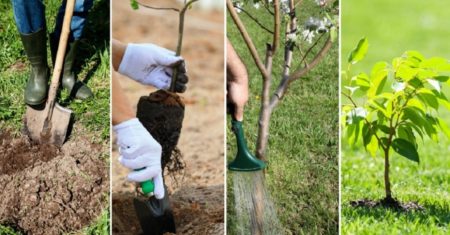

When to plant cherries, in spring or fall? There is no unequivocal answer to this question, but in the spring, seedlings are subject to many dangers:
- return frosts;
- strong winds;
- sudden changes in temperature.
In the fall, seedlings will face fewer dangers than in the spring. Their root system takes root well. They develop much faster than trees planted in spring. In addition, the long winter rest stimulates the healing of injuries. The tree receives minor injuries during transplantation into open ground.
During the winter dormancy period, cherry buds do not grow, and the root system is actively developing underground. In the spring, when the buds begin to awaken, the powerful root system promotes the active build-up of green mass.
Before buying seedlings, you need to keep in mind the peculiarities of their storage in nurseries. If the nursery sells material intended for spring planting, it is dug up and stored throughout the winter. Despite the observance of the storage rules, this method violates the natural development of the tree. The seedling's roots or structure may be damaged. It is difficult to determine in appearance.
Planting cherries according to the lunar calendar
Many gardeners and summer residents "consult" with the lunar calendar when planting garden and horticultural crops. And there is a logical explanation for this, since plants are a part of nature, all phenomena in which are interconnected.
Biological scientists have long studied the effect of moon phases on tree growth and came to the conclusion that some species develop better if they were planted on a growing moon, others, on the contrary, on a waning one. Cherries, like many upward-growing plants, are best planted when the moon is gaining strength and growing.
On a full moon, trees are at their peak of development, so they do not need outside help - they cannot be cut or transplanted at this time. But the harvest harvested on a full moon will be of excellent quality. Plants rest on the waning moon. At this time, you can do pruning and fertilizing, and closer to the new moon - fighting diseases and pests.
With the change of phases, the visible outlines of the moon also change.
Table: lunar calendar for planting cherries in 2019
Cherries can be planted both in spring and autumn - it is important to choose the right time. In the southern regions, the timing of planting does not significantly affect the result. In regions with cold winters, during autumn planting, it is necessary to provide the young plant with proper wintering or to dig it in.
If you have any difficulties or problems, you can contact a certified specialist who will definitely help!
Tell me when to plant cherries? Dumplings with sweet and sour cherries are the most popular summer delicacy in our family. But there are not enough berries all the time, especially since I still make preparations for the winter. Last year we bought seedlings and planted them in the fall, but none survived the winter. Maybe we planted late or is it generally better to do it in the spring? But in our area it is difficult to guess the spring weather, besides, in the fall, the choice in the nursery is the best. How to proceed?
In general, mature cherries winter well in almost any growing region, but young trees are more sensitive to frost. And above all this applies to newly planted plants. Timely planting is the key to not only successful rooting, but also a stronger and more developed tree. Gardeners are a little late in the fall or rushed in the spring - and poor seedlings freeze and begin to hurt. Sometimes they wither and disappear altogether.It is important to know when to plant cherries to avoid waste and enrich your garden with new varieties.
There are two periods when planting is most favorable:
- Spring;
- early autumn.
The specific dates of disembarkation differ slightly depending on the regional climate. Weather conditions play a decisive role in both cases. Which is better: spring or autumn? Let's take a closer look at this issue.
Site preparation for planting
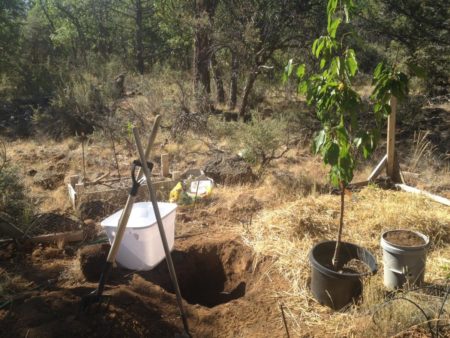

Cherry trees have a lifespan of 18 to 25 years when properly planted and well cared for. When choosing a landing site, several factors are taken into account. First of all, this is lighting. Better to plant cherries on a hill. If there are only gentle slopes on the site, the one that faces south or southwest is chosen from them. Also, the site must be protected from cold winds and drafts.
The ideal soil for cherries is loam or sandy loam, which has a neutral alkaline reaction. At the same time, the groundwater level should be no more than 1.5 m in depth. If the site consists of an acidic peat bog, such soil is not suitable for cherries. Its top layer is replaced by 20 cm.
Before planting seedlings, the following fertilizers are applied to the soil:
- from 8 to 10 kg of manure or compost. In the fall, fresh manure can be applied;
- 60 g superphosphate;
- 30 g of potassium chloride.
The number of components is indicated per 1 m2 of soil.
When preparing the landing hole, several nuances are taken into account. The root system of the tree in a straightened form should fit into the hole. The depth of the hole is 45 cm, the diameter is about 60 cm. The soil dug out during the preparation of the hole is evenly laid out on the sides. After planting, the roots of the tree are carefully covered with it.
Alternative way
Cherry, bush, tree, columnar cherry - whatever type of culture is chosen, they are planted in the manner described above. The only exceptions are heavy dense loams and areas where the groundwater level is high. In order for the cherry to easily and quickly take root on them, you need to properly prepare the place for the tree.
The secret is simple: they place it not in a hole, but on a hill. First, a small hole about 25 cm deep is made in the ground. After adding fertilizers to the fertile soil, pour the nutrient substrate from above. It should fill the recess and form a mound 25-30 cm high.
The tree will grow in this pile of land. Otherwise, its fit is no different from the traditional method. The roots are straightened, sprinkled with earth, compacted, watered abundantly and mulched. Upon closer examination, it becomes clear that the depth of the planting pit in this case is still 50 cm, just 25 of them are above the soil surface, and 25 are below it.
Correct disembarkation dates
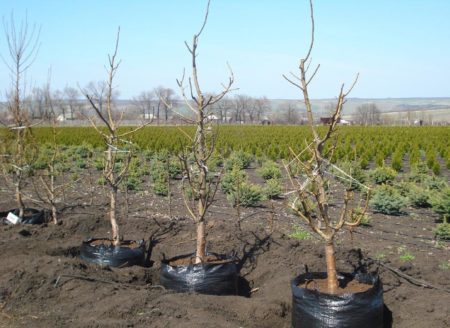

The timing of planting cherries depends on the climate in a particular region. There are several general rules that will allow you to grow healthy and strong trees:
- cherries are planted 2-3 weeks before the first frost so that the roots have time to take root. If you neglect this rule, the roots will be weak due to constant freezing and thawing;
- in the Moscow region and other regions of the Middle Lane, trees are planted after all the leaves have fallen off. The planting season lasts until the second half of October;
- in the south, cherries are planted in early October. Disembarkation season lasts until November 10-15.
An exception is also made for trees with a weak level of frost resistance. They are also planted in the spring. If the gardener missed the favorable autumn terms, the planting is postponed until spring. The seedlings are stored in a digging trench, placing them in a hole at an angle of 30 degrees. The root system and the root collar are covered with earth. Shoots must be bent to the ground and fixed with a load.
A step-by-step guide to planting a seedling
Before boarding, you need once again inspect the seedling, cut all damaged areas of the roots to healthy tissue.All leaves are removed, which will facilitate the evaporation of moisture.
If the roots are very dry, then they need to be immersed in cold water for 12 hours before the root collar. In some cases, the trunk of the seedlings also dries up, in which case it will need to be immersed in water by 1/3.
Significantly increases the survival rate of seedlings immersion of roots in a solution of heteroauxin - organic growth stimulant.
Step-by-step guidance and planting steps:
- installation of a stake (2 m) on the north side of the pit;
- the formation of a mound from the prepared soil mixture;
- even distribution of cherry roots over the surface of the mound;
- backfilling of roots and compaction of the surface of the trunk circle;
- watering with 2-3 buckets of warm water.
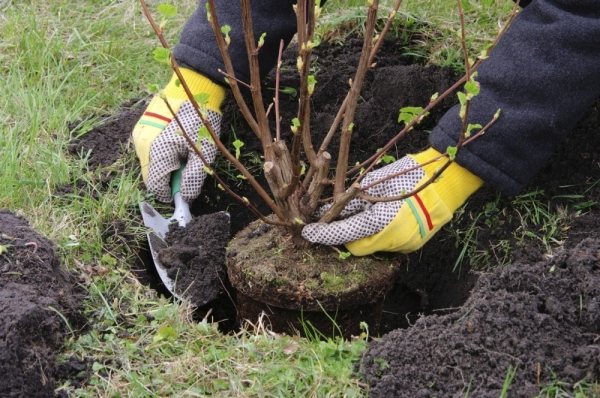

Inspect the roots before planting; cover the seedling with earth so that the root collar remains 3-5 cm above the soil surface
Root collar should remain 3-5 cm above the ground surface. Over time, shrinkage will occur, and it will level with the soil. If, after watering and shrinking, the root collar is still not at the desired level, it needs to be corrected.
This indicator also applies to bushy varieties, despite the name, they are planted in the same way as tree cherries.
Planting cherries:
Choosing good seedlings
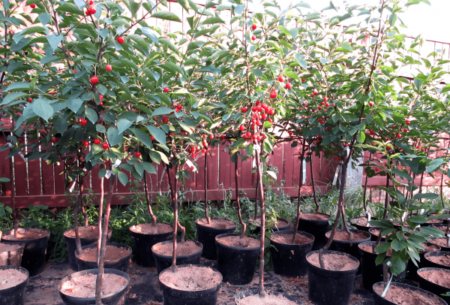

When choosing a seedling, you need to be guided by the following indicators:
- annual length - from 70 to 80 cm;
- the length of a two-year-old is from 110 to 120 cm;
- development of the lobe of the root system - from 25 cm and above;
- whole, mature wood.
You should not buy too high planting material. This is a sign of overfeeding with nitrogen fertilizers. Such trees can die in frost.
As already mentioned, there are own-rooted cherry varieties that can bear fruit without the help of pollinators. However, grafted varieties enter the fruiting phase earlier.
How to choose a cherry variety for planting in the Moscow region
So that the work does not go to waste, and the new inhabitants of the garden please with abundant harvests, the choice of planting material must be approached with all responsibility:
- Seedlings must be purchased from trusted suppliers in nurseries.
- Zoned trees, frost-hardy and winter-hardy, resistant to such diseases characteristic of the Moscow region as coccomycosis and moniliosis, are suitable.
- You should pay attention to the flowering time and yield of the variety, as well as taste, because trees are acquired for the sake of tasty, juicy berries.
The most popular in the Moscow region, as well as throughout central Russia, are the following cherry varieties:
- Chocolate girl. Differs in average productivity and high resistance to diseases.
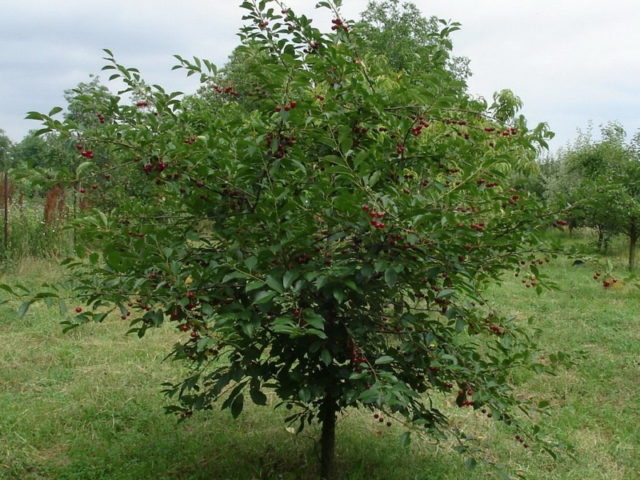

- Turgenevka. It tolerates northern winters well, the berries are juicy, sweet and sour. Resistant to cherry diseases.
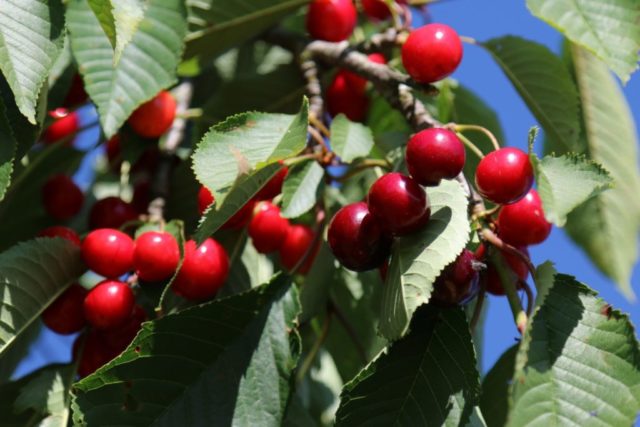

- Apukhtinskaya. A high-yielding variety, but does not tolerate frost well. A self-fertile variety, but to increase yields, you can plant the varieties Schedraya, Malinovka, Lyubskaya, Zhuravka nearby.
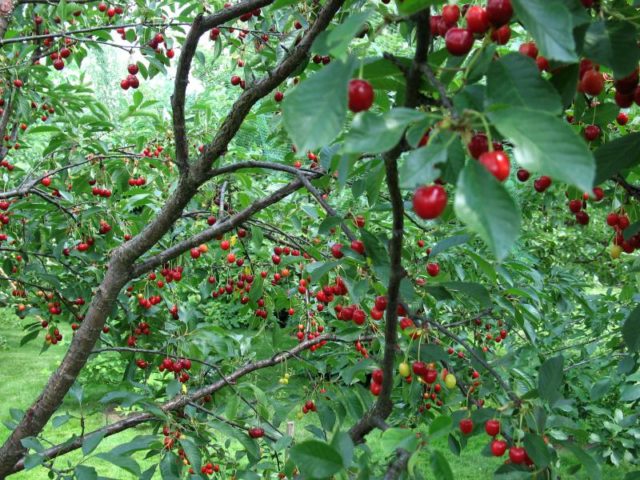

- Volochaevka. Frost-resistant, high-yielding, resistant to coccomycosis. The variety was bred in the 80s of the twentieth century and belongs to medium-sized.
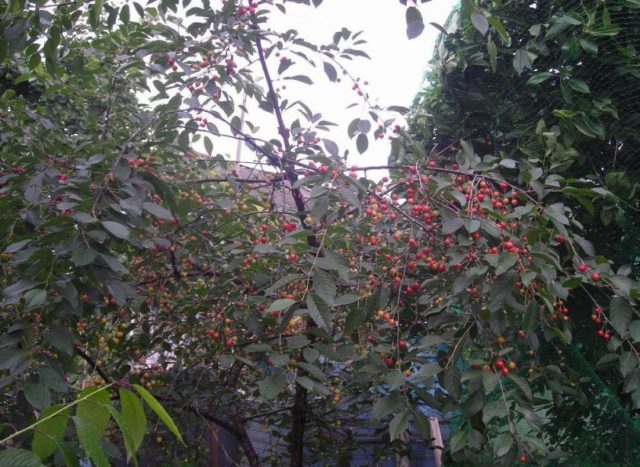

- Youth. Gives bountiful annual harvests, tolerates severe winters well. The berries are distinguished by good keeping quality, keeping their presentation up to 15-20 days after harvest.
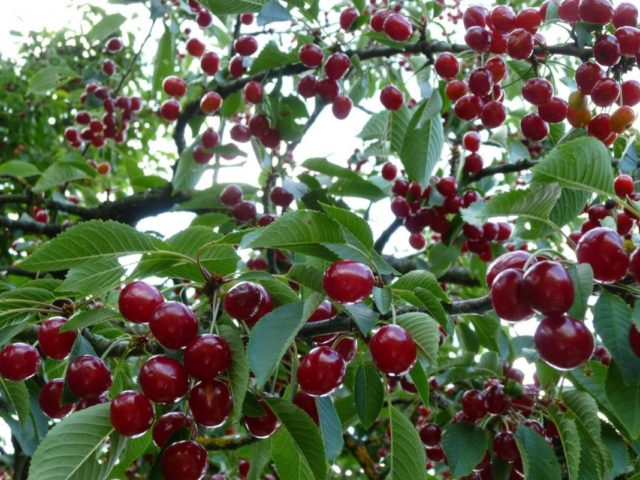

- Lyubskaya. Self-fertile, winter-hardy and practically not susceptible to disease. It has been known since the 19th century, was originally grown in the Kursk province and belongs to varieties of folk selection.
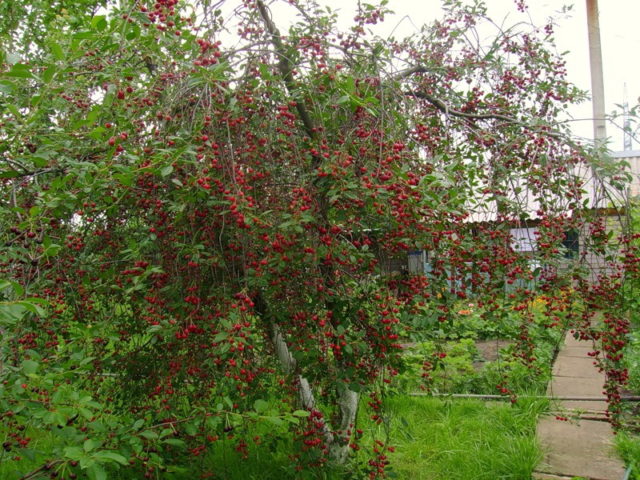

Planting of several different varieties is recommended, suitable for cross-pollination.
Comment! The name "cherry" comes from the common Slavic "bird glue", the original meaning of the word was - a tree with sticky sap.
Disembarkation process
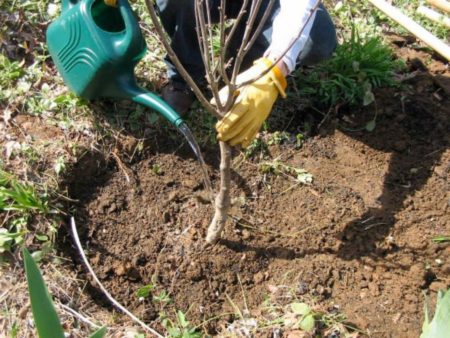

Before planting, all seedlings are examined. If their root system is damaged, it is carefully pruned. All foliage is removed from the material so that moisture does not evaporate. The roots should be moderately moist. If dry, they are kept in cold water for 12 hours. Sometimes on sale there is planting material with dried trunks.It is immersed in water by a third and kept for 12 hours.
Roots can be immersed in heteroauxin 3-4 hours before planting. It is an organic growth stimulant that promotes good root survival.
There is a step-by-step guide for planting young cherries:
- set the stake with the direction to the north (stick length - 2m);
- at the bottom of the hole, make a mound from the nutrient mixture;
- spread the roots over the mound;
- cover the roots of the seedling with soil;
- compact the surface of the earth and the trunk circle;
- water the closed seedling with warm water. For one tree, 2 to 3 liters will be enough.
The neck of the root should be left 3-5 cm above the top layer of the soil. As it shrinks, it will gradually be compressed to the ground.
Sapling selection
For cherry planting to be successful, you need to choose the right crop variety. They are guided here first of all by the peculiarities of the local climate. For regions located in Central Russia, varieties of cherries with good frost resistance are suitable: Shokoladnitsa, Nizhnekamskaya. In the south, more thermophilic varieties are successfully grown: Bagryanaya, Zhukovskaya. For the Moscow region, it is better to choose trees that are not affected by fungal diseases: Toy, Shubinka. In the Urals, cherries Ashinskaya, Bolotovskaya, Mayak have proven themselves well. In the harsh weather conditions of Siberia, the varieties Altai Swallow, Metelitsa, Shadrinskaya will be able to survive and bring a generous harvest.
When choosing a seedling, they carefully examine its roots. They must be strong and well developed, free from damage, signs of disease or insect infestation. The wood must also be examined. In a high-quality seedling, it will be ripe. Young trees, at the age of 1-2 years, which were grafted with a cuttings, have a good survival rate. Usually their height is 80-110 cm. From 3-4-year-old seedlings, it will take longer to wait for the harvest. All leaves are removed from the future tree to avoid dehydration. After moistening the roots of the seedling, they are wrapped in a damp cloth, and a layer of film is added on top. This way they will not dry out.
You can buy cherries in the fall. If it is planned to plant it in the spring, the tree is buried. In the area where the snow lingers the longest, a furrow of medium depth (35-50 cm) is prepared. Its southern wall is made inclined (30-40 °). A seedling is placed in it, with its roots pointing down. Its crown should face south. This will protect the tree trunk from burns. Then the cherry is sprinkled with soil to the side shoots.
Having tamped well and abundantly watering the ground, the crown of the tree is covered with spruce branches. It will protect the branches from frost and rodents. From above, the shelter is covered with a thick (0.5 m) layer of snow. It is advisable to do this before frost. The trees are removed from the furrow only before being placed on a permanent site.
Possible problems
Novice gardeners often make mistakes that harm the cherry and affect its growth and yield. Major flaws:
- The planting hole is not prepared in advance, so the root collar goes deep underground, which impairs the growth of the tree.
- A large amount of fertilizer is applied, which has a bad effect on the root system.
- They buy a seedling older than three years, because of this, the cherry takes longer to adapt in a new place.
- The tree is not planted on time, which becomes a frequent cause of death.
- They buy a seedling from the hands, and not in nurseries, where the quality is guaranteed.
Diseases, pests
| Optimal timing of autumn planting | ||
| Middle lane and Moscow region | from early to mid-October | The seedlings are planted when the temperature is favorable for quick adaptation and establishment. |
| Southern regions | from mid-October to mid-November | The plant, having gone into the dormant period, gets into conditions that are optimal for adaptation. |
| Northern regions and the Urals | beginning of September | Frosts come early here, it is important to have time to plant seedlings on time. |
| Pest / disease | Problem | Elimination method |
| Clasterosporium disease | Numerous holes and round brown spot on the leaves. | The diseased leaves and infected parts of the cherry are removed.Then a solution of copper oxychloride or cupritox is used. |
| Coccomycosis | Small bright red and pale spots on the leaves, pink spores appear below. After the leaves turn yellow and fall off. | The leaves are destroyed, the soil is dug up at the trunk. The tree is treated with copper oxychloride. |
| Moniliosis | A spot appears on almost every fruit, which eventually fills it entirely. The tree loses all of its harvest. | The affected parts of the cherry are collected and removed. After using Bordeaux liquid. |
| Rust | The leaves are covered with rusty spots and fall off. | The affected parts of the tree are collected and burned away. |
| Scab | Huge dark spots appear on the inner side of the leaf, then they turn brown and dry. | The leaves are burned, then the tree is sprayed with Kuprozan. |
| Cherry sawflies | Destroy all leaves to the veins. | Trichogamma (natural enemies-egg-eating sawflies) are released, treated with Pyriton. |
| Cherry weevil | Green beetle, which eats leaves, cherry buds. | Aktelik and Rovikurt are used. |
| Aphid | Sucks sap from wood tissue. The leaves are wrapped in a tube. | Sprayed with chemicals such as Rovikurt or tobacco tincture with the addition of soap. |
| Plum moth | The butterfly lays eggs in green fruits. The berries go bad. | It is treated with benzophosphate and carbophosphate. |
Digging in cherry seedlings for the winter
It so happens that the weather and time on the calendar no longer allow planting cherries in the fall, but the seedlings are bought. In this case, the most important thing is to save them until spring, and digging will help here.
- Choosing a place for a groove where young trees will be dug. It is desirable that it be a sunny place, protected from the winds, and in the spring it is necessary that it is not flooded with melt water.
- There should be no debris or compost heaps nearby in order to avoid the appearance of rodents.
- Digging a groove (depth - up to 50 cm, width - 35-45 cm), while removing all weed roots from the soil, dig up and loosen the soil. The direction of the groove is west-east. In this case, the slope, which is southern, is made with a slope of about 45 degrees.
- Leaves are removed from cherry seedlings, the roots are carefully straightened, and they are carefully laid in rows in a groove, while the tops should be directed to the south.
- If the soil in the groove is dry, you can spill it lightly, if there is enough moisture, then there is no need to water.
- The roots are covered with earth, then the soil is carefully compacted with a shovel.
- Until the first frost, you can leave everything as it is, but with the onset of cold weather, the seedlings need to be sprinkled with soil to the tops.
- If the winters in the region are frosty, it is good to cover the young cherries with spruce branches and snow. But you should not insulate too much, as the seedlings can support.
Recommendation! Experienced gardeners often lay out prickly branches of rose hips and blackberries near dug-in seedlings to protect them from rodents in the open field.
In the spring, the seedlings need to be carefully dug up and examined. Only healthy trees are suitable for planting, the rest that have not survived the winter are rejected.
Choosing the landing time
Let's decide now when and how to plant cherries in the suburbs? Optimally, this is spring, but at the same time we choose the moment so that the buds have not yet begun to bloom (in this region, this time is until the first ten days of April).
Autumn planting is also possible, but there is an exact guideline - no later than early October. Of course, you always need to look at the features of a particular year, otherwise young seedlings may get frozen.
If the cherries are purchased, and the weather does not allow planting in the fall, the seedlings should be dug in. For which they dig a small trench, lay the seedlings with a slope there, sprinkle the roots with earth and spill it a little. Then they are covered with branches of spruce or pine, you can use sawdust, and then, when the snow falls, sprinkle with snow. In this state, the seedlings will successfully overwinter and will be ready for planting in the spring.
Planting seedlings
The roots of the seedlings are carefully straightened, the damaged ones are removed.A peg is driven into the middle of the pit, and a little well-rotted compost or humus is poured onto the bottom, then sprinkled with earth slightly. And only then the cherry is set, trying to keep its trunk to the north of the peg.
The pit is carefully covered with earth, the soil is not rammed, but only slightly compacted. After that, they make a circular hole around the cherry, pour a bucket of water there, and carefully mulch the ground with peat, humus or sawdust.
Now we will observe the planted seedlings, and carry out all the care activities.
Good landing site is half the battle
The plant is quite tolerant of the quality of the soil. Prefers medium and light loamy, sandy loamy neutral soils. If the soil is acidic, apply liming. The groundwater must be at least 1.5 meters away. Before planting cherries in the fall, choose the most suitable place for the tree. Everyone's favorite prefers lighted areas. Plant the seedling on a windless slope or high ground in the southern or southwestern part of the garden. As for the lowlands, the conditions are unfavorable. Water stagnation occurs regularly, the area is blown by winds. There is the coldest microclimate, high humidity. Such conditions contribute to the development of fungal diseases of cherry: coccomycosis, moniliosis, anthracnose and many others. The consequence of diseases is rotting of fruits, gum removal, damage to the trunk, shoots, leaves. Correct planting of the plant is the main means of preventing most diseases. When planning a place, keep in mind that the lifespan of a bush-like cherry is 18 years, and a tree-like one is 25 years.
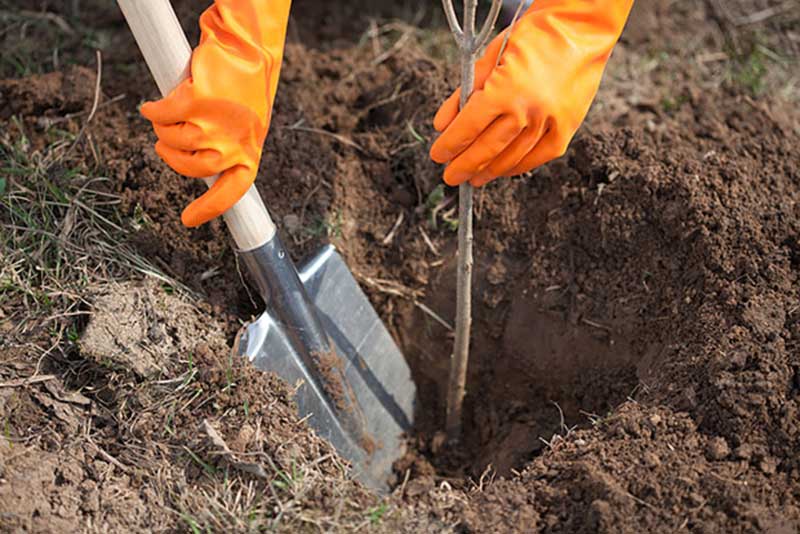

Gardeners reviews
Terenty
Cherry varieties "Pamyat Yenikeeva", Molodezhnaya for the southern districts of the Moscow region. Vladimirskaya is very sick with moniliosis.
Alexander Shulekin
What, in my opinion, is important: we need varieties that bloom as late as possible. It is also very good if the variety is self-fertile.
Seat selection
Cherry loves sunny places, therefore, a well-heated and well-lit place is chosen for it on the site. The soils are loam and sandy loam, while melt water should not stagnate here.
If on an area of soil with high acidity, then liming is necessary. It is very important to take care of the quality of the soil in advance; you also need to prepare the pits for planting in advance. For spring events, the pits need to be prepared in the fall.
The dimensions of the pits are approximately 60 cm in diameter and 100 cm in depth. The distance between the planting pits should be at least two and a half meters. Novice gardeners often forget about this, and when the trees grow, problems arise in caring for them (wide crowns, poor lighting).
Preparing cherries for winter
Follow the advice of experts who recommend to carry out wood insulation before the onset of cold weather:
- Mulch the soil of the near-stem circle of the seedling with a layer of 10 cm of peat (sawdust), carry out hilling by 30 cm.
- Tie a material (such as a bag) around the stem of the cherry.
- Insulate with branches, spruce branches (best).
- To scare off rodents, it is necessary to treat cherries in the fall with a mixture of manure and clay in a 1: 1 ratio. Additional information about tree care can be found on the Internet by typing “cherry in autumn care”.
How to care for cherries in spring? First of all, remove the wrap and peel back the hilling. In general, the rest of the care is not much different from the care of the rest of the trees. Whether it is possible to plant cherries in your region in the fall, you need to determine by studying the temperature readings. Either way, plant these fertile trees in your garden and take care of your cherries. They will delight you and your family with annual harvests. For your information, cherries can also be planted in the fall.
Optimal timing for planting in the fall
The exact timing of planting a tree in the fall depends on the specific region and weather conditions.It should be assumed that cherries should be planted in the ground no later than 18-22 days before the expected onset of the first frost, otherwise, under the influence of night frosts, the root system of the tree may constantly be subject to freezing and subsequent thawing. If this is not so dangerous for a rooted adult tree, then a young seedling simply will not be able to take root.
Important! The greatest danger for a seedling during spring planting is represented by recurrent night frosts, cold wind, and a large difference in air temperatures during the day. In addition, in spring, the dormancy period that a tree needs for normal adaptation and development is much shorter.
If we talk about some specifics, then under typical weather conditions, the approximate timing of planting a tree in the ground is as follows:
- the middle zone of Russia, the north of Ukraine and all of Belarus - after the leaves fall and until the second decade of October;
- in the south of Russia and most of Ukraine - all October until the second decade of November;
- northern regions of the Russian Federation and the Urals - cherries are planted exclusively in the spring.
You should also take into account the variety: if it does not tolerate frosts (especially in the middle lane), then it is better to plant a tree in spring. In the event that, for whatever reason, the most favorable time for planting is missed, you should not rush to try to catch up. In such a situation, the more correct solution would be to leave the seedlings before the spring planting, correctly preserving them.
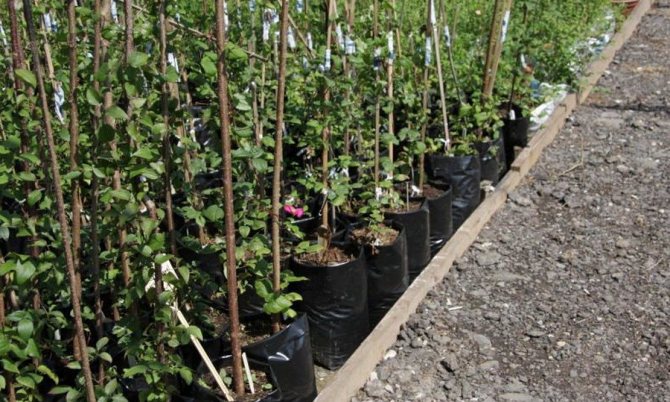

This is done using the digging trench method, which is quite simple:
- A trench is dug along the west-east axis, 0.3–0.4 m wide and deep, with a sloping southern edge, the ascent angle of which is approximately 30 °, and a steep northern one.
- The seedlings are placed in the pit (after preliminary processing) so that the roots and root collar are in the trench, after which they are covered with earth.
- The trunk and branches are lowered to the ground, covered with pruned prickly branches of elderberry or rose hips (to scare away rodents).
Did you know? For most people, cherries strongly associate with a small compact tree. However, in England, a cherry tree grows, reaching a height of 13 m (this does not quite reach the height of a five-story building), its age
—
over 150 years.
Outdoor care
For proper growth, development and fruiting, cherries are looked after.
Watering features
A shaft of earth around the trunk of about 25 cm is poured onto the seedling, and about 2 buckets are slowly poured into this hole. After absorbing moisture, the soil is mulched at the tree trunk. After that, the cherries are watered as needed.
Fertilizers
In order for the cherry to grow well in open ground, fertilizers are applied. For the first two years, they do not. And from the third year to the first flowering, nitrogen-containing fertilizing is introduced. The best option is to apply fertilizers to the water. As soon as the cherry blossoms, they feed it with humus, compost. In the summer they use any organic matter. In autumn, potassium-phosphorus fertilizers are suitable, for example, potassium monophosphate.
Pruning
Cut off the seedling immediately after planting. From the ground to the first branch, 50 cm of a bare trunk should remain, all the rest should be cut off. Only 6 strong branches are left at an acute angle to the cherry trunk - this is the main crown of the plant. These branches are shortened by about 7 centimeters. The rest are cut to zero, to a hemp on the trunk, the cuts are smeared with garden pitch.
The crown is formed as follows:
- They begin in early spring, cutting off the one-year-old shoot by 80 cm in height. This will be the first level of branches.
- Next year, the central conductor is cut from the highest branch to the first level by 80 cm. This will be the second tier with three branches around the circumference of the tree.
- Once the crown is formed, the cherry is limited in height to 2.5 meters. Frequent branches thin out.
Reproduction
Cutting method:
- Indicate about a 2-year-old growth near the mother tree next to strong roots.
- A cutting is not taken close to the root system, otherwise the roots of the mother tree will be damaged. After that, the root connecting the shoot and the mother tree is cut off. Already in the spring, this process is transplanted to a new place.
Bone propagation method:
- Fresh bones are dried and placed in water for several hours. Seeds that have gone to the bottom are suitable for planting, and the floating seeds are removed.
- The first ones are placed in a container with sand and water and left until warm weather in a dry place, weeds are moistened and weeded as needed.
- They are fed a little with fertilizers (superphosphate, potassium chloride).
- For the winter, the seedlings are covered with foil and left in a cellar or any other dry place.
What care is needed for young trees
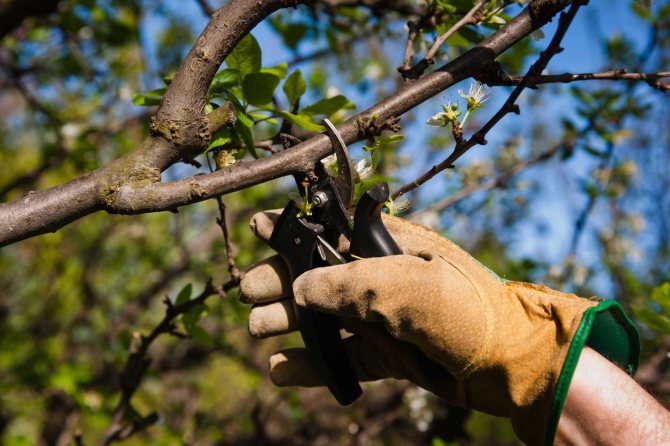

When cherries begin to bear fruit, they should be fed annually.
Young cherries planted in autumn do not require special care - they need more rest and time for rooting. If the weather outside the window is rather warm, the trees can be watered several times, but after the onset of frost, watering completely stops. Further care for cherries depends on the climate in the region and the amount of precipitation.
Central Russia, Leningrad Region and Moscow Region
Here, the end of autumn is often rainy, and excess moisture can be detrimental to the roots. If there is a large amount of precipitation around the trunk circle, you need to make small grooves for the outflow of water. Winters often have little snow - in this case, it is necessary to warm up the snow on the trunks so that the trees can winter normally.
Ural and northern regions
Young cherries should be wrapped in burlap or non-woven material, and spruce branches on top - this will help protect them from freezing.
Southern regions
In the south, special preparation for winter is not required, but it is advisable to take measures against rodents. A mixture of clay and mullein, which has a pronounced unpleasant odor, will help scare off pests - it should be applied with a thin layer to the tree trunk.
Possible mistakes
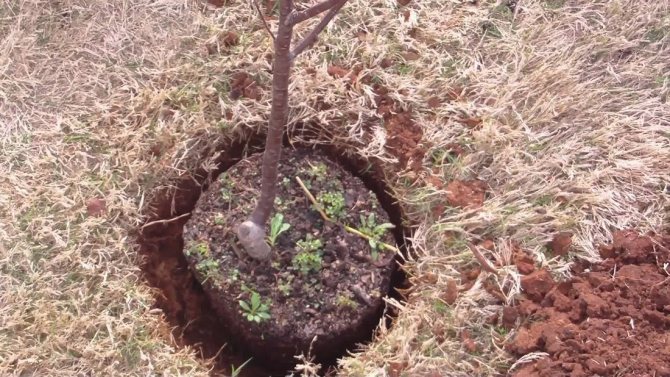

Inexperienced gardeners choose too large seedlings for planting, trying to get a good harvest as soon as possible. The age of such plants exceeds the recommended age for planting 1-2 years. They do not take root well, they often get sick. Also, do not purchase a large number of plants in advance. The trees dug out early do not have time to enter the resting phase. Such seedlings do not take root well either.
Important! Do not use fresh manure or bird droppings as fertilizers. They contain a large amount of ammonia, which slows down rooting and worsens the condition of the plant. To fertilize the crop, do not use a lot of mineral fertilizers. Their excess causes the death of soil bacteria, which convert substances dissolved in the earth into a form that is available for assimilation by plants.
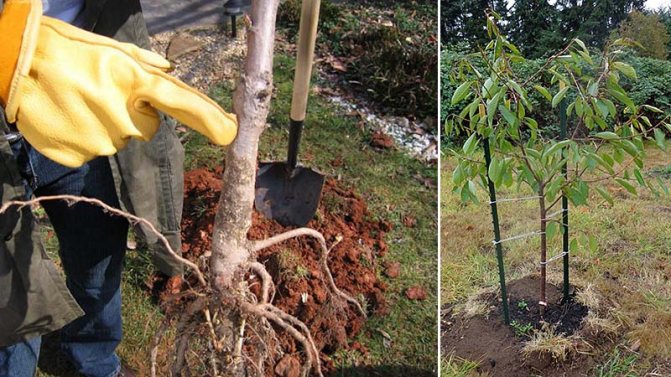

Do not dig up a plot for planting cherries right before planting seedlings. It is better to do this work in advance - a few months in advance, or at least 15-20 days in advance. The hole is dug at the same time. If these recommendations are not followed after planting, the root collar sags too deeply.
Planting cherries is easy. A plant planted in the fall takes root successfully if the procedure is performed on time. It does not need special care, except for water-charging watering and shelter for the winter. All other activities are postponed to spring and performed after the establishment of warm weather.
The choice of planting material
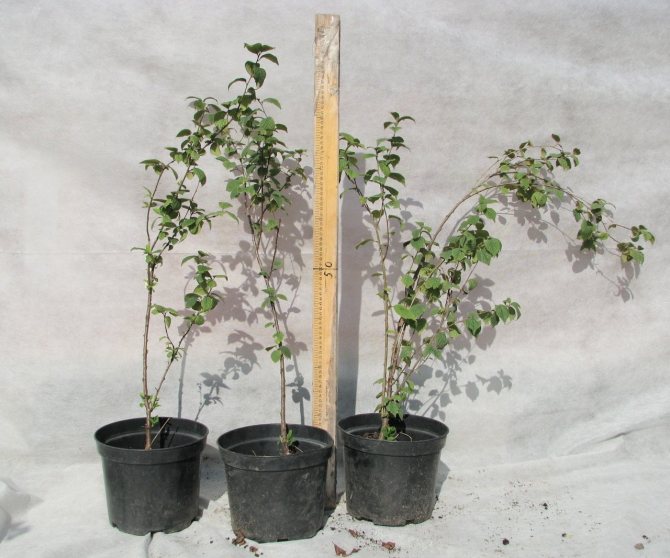

In order for the seedling to be well preserved, it must not be buried in the lowlands, where melt water will accumulate in the spring.
The right choice of a seedling plays an important role. It must meet the following criteria:
- the height of annuals is 70–80 cm, of biennials - 110–120 cm;
- the root system is well developed, the roots are at least 25 cm long;
- mature wood without defects, damage and traces of damage by pests.
For autumn planting, it is better to acquire winter-hardy varieties of culture, especially if you plan to plant them in the Middle Lane or in the Moscow region.Varieties that do not tolerate lower temperatures may not take root and freeze after the onset of cold weather.
Recommended varieties for the middle lane:
- Miracle,
- Chocolate girl,
- Lyubskaya,
- Morozovka.
For the southern regions and the Central strip, the following are recommended:
- Zhukovskaya,
- Turgenevka,
- Kharitonovskaya,
- Baby.
Felt cherries are distinguished by the minimum whimsy in terms of temperature. They do not grow only in arctic and subarctic climates.
Planting work
The planting procedure includes many different actions aimed at creating optimal conditions for the cherry seedling being planted.
Seat selection
When the seedling is selected and prepared, you need to make the right choice and preparation of the planting site.
It is important to know where to plant cherries:
- cherry loves sunny areas of the southern slope, not shaded by large trees, buildings;
- if bush cherry is placed near the fence, it will be protected from piercing cold winds and frost.


Soil requirement
Fertile loamy soils are most suitable for cherries, where groundwater is located no closer than 2 meters from ground level. The acidity of the soil should be neutral or close to this indicator.
If the soil is sour peaty, you should not plant cherries in it right away. It needs to be limed for 2 years for planting, then planting is possible. It is allowed to grow a crop on soils with a sandy texture, but peat or humus must be added before planting.
Landing scheme
Cherries are of different types in height and crown spreading. Depending on this, the interval between the planted seedlings is selected. Felt cherry, for example, is never high, which means that the distance between seedlings when planting should be minimal.
As usual, cherries are not planted alone. Pollinating varieties are placed next to the main variety.
Planting scheme for different types of cherries
| The size of the tree | Interval, meters |
| felt cherry and other bush types | 2 × 2 |
| low tree cherries | 2 × 3 |
| tall | 3 × 3,5 |
Important! When selecting pollinators, you need to choose varieties that bloom at the same time as the main variety.
Soil preparation, pits
To be successful in a planting campaign, you need to know how to properly prepare the site and the planting pit.
Site preparation
Preliminary preparation of the site includes the following list of works:
- digging the soil to a depth of 30 cm;
- cleaning the site from stones, debris, rhizomes of perennial plants;
- leveling the surface of the earth.
When planting in spring, this work is carried out in the fall, after harvesting the previous crop. If cherries are planted in the fall, preparation is carried out 2-3 weeks before the proposed procedure.
Digging a hole
Pit preparation is essential to your ultimate success. It includes 2 stages:
- direct excavation of the groove;
- preparation of nutrients to be put in the pit.
The volume of the planting pit directly depends on the volume of the root system of the seedling. Usually the depth, width and height of the pit are taken equal to 60 cm. If the cherry roots have a large volume, the size of the pit will have to be increased.
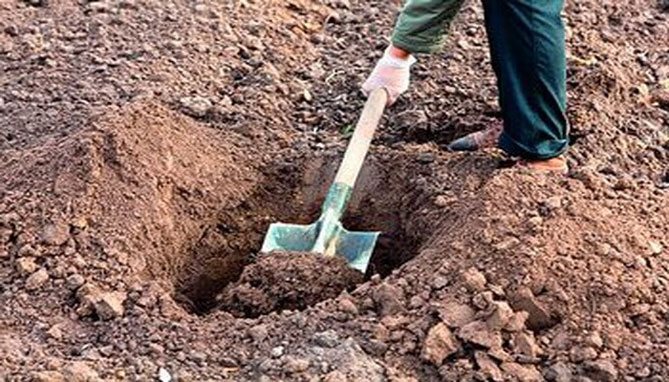

When digging a hole, the top layer is folded separately, so that it can then be used to prepare a nutritious soil mixture.
Fertilization
The next important stage is the introduction of fertilizers into the pit for better survival of the seedling and its starting growth. For this purpose, a mixture is prepared, consisting of the following components:
- removed topsoil - 1 part;
- rotted manure - 1 part;
- horse peat - 1 part;
- superphosphate - 55 g.
A stake is driven into the center of the recess, which will subsequently support the seedling. The pit is filled to 3/4 of its volume with the prepared nutrient mixture. Until the day of planting, this soil will settle a little and it will become possible to carry out the planting procedure.


Landing in the fall
Autumn planting is preferable for areas with warm or temperate climates. Saplings are planted at the start of November, and before the onset of winter they have time to take root and take root.


The planting procedure is performed using the following technology:
- the roots of the seedling are soaked in water for a day;
- water the pit abundantly;
- dip the roots in a clay mash;
- put a tree with its roots on a mound in a hole and spread the roots;
- sprinkle the roots with soil mixture;
- compact the soil;
- tie a tree to a peg;
- pour 1 bucket of water into the pit;
- the trunk circle is mulched.
Important! After planting the seedling, the root collar should be at the same level with the soil, and the grafting site should rise by about 5 cm in relation to this level.
Planting work in spring
For spring planting, the pit is prepared in the fall. If all the preliminary work on the preparation of the site and the pit is done in the fall, the spring planting takes place according to the following algorithm:
- part of the land is removed from the landing pit, forming a mound;
- a wooden stake is driven into the center of the recess;
- a seedling is installed on a mound so that the root collar is flush with the ground;
- gradually cover the roots of the plant with soil mixture;
- the soil is slightly compacted;
- 2 buckets of water are poured into the pit;
- a tree is tied to a stake;
- the trunk circle is mulched with humus or peat.
How to plant with a closed root system
Planting cherry seedlings with a closed root system has some differences from the traditional planting of a cherry tree. These seedlings are sold in special containers with soil.
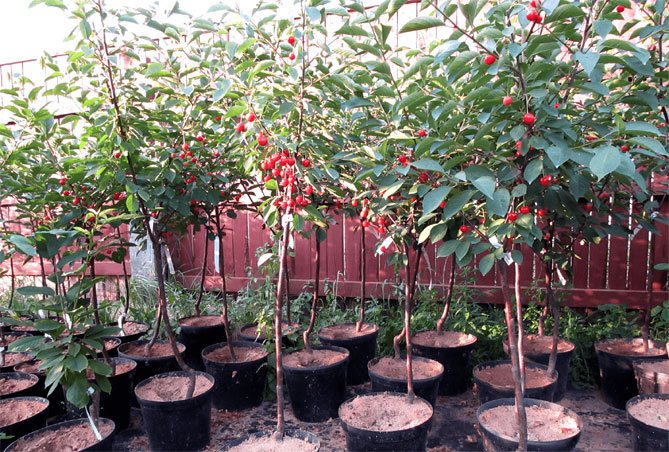

The roots of such a cherry are in moist soil, it can be stored for a long time before planting. You can plant it on any day of the warm season. It is not recommended to schedule the landing procedure on hot days.
The planting of these seedlings is carried out as follows:
- prepare a pit 2 times the volume of the container;
- a drainage layer is laid on the bottom of the pit;
- an earthen lump of a tree along with roots is installed in the pit;
- the space around the coma is covered with soil;
- water the tree abundantly;
- the trunk circle is mulched.
Features of landing at a high level of groundwater
If in the area where the cherry trees are planned to be planted, the groundwater lies closer than 2 meters to the ground level, then it will not work to lay a cherry orchard without preliminary preparation.
In this case, you will need to make an artificial embankment from the soil in order to raise the ground level as much as necessary. The roots in such a place will not grow to water, cherry trees will develop normally.


How to properly plant a closed-root cherry seedling
For planting seedlings with a closed root system, the soil requirements are the same as for planting with an open root system. It is better to plant trees in warm, humid weather, when the temperature is still within + 10-13 ° C.
The hole is dug to the height of the coma. It is not necessary to deepen the graft, it must be above the soil level. Carefully remove the film from the earthy clod,
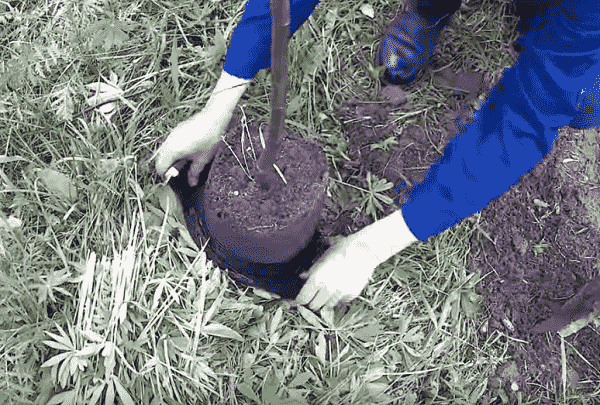

and then the earthen lump itself must be carefully loosened with a knife in vertical movements so as not to damage the roots. At the same time, an easy pick will occur, the roots will gain freedom and then take root better. Otherwise, they will be in this coma for a long time.
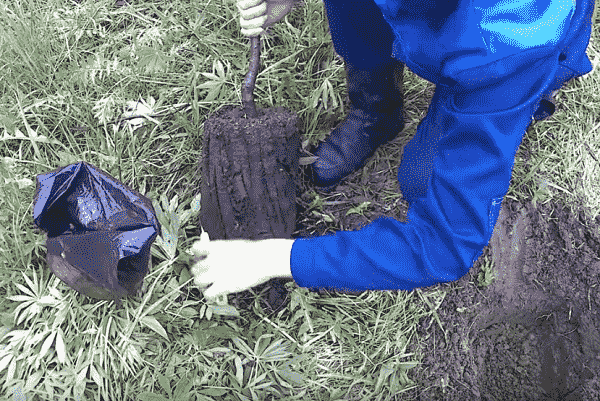

The seedling in the hole is placed so that the more developed branches are on the north side. They cover it with earth. The soil in the hole is crushed with a shovel so that it lies tightly.
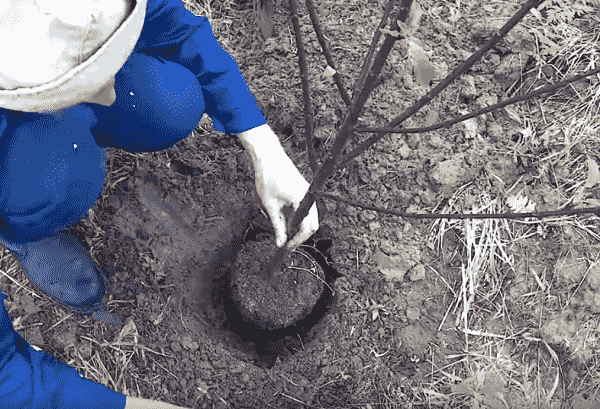

You do not need to insert a peg. Usually, in the package, the tree is already strengthened and it no longer needs support.
Then the hole is poured with water at the rate of 0.5 buckets per hole.
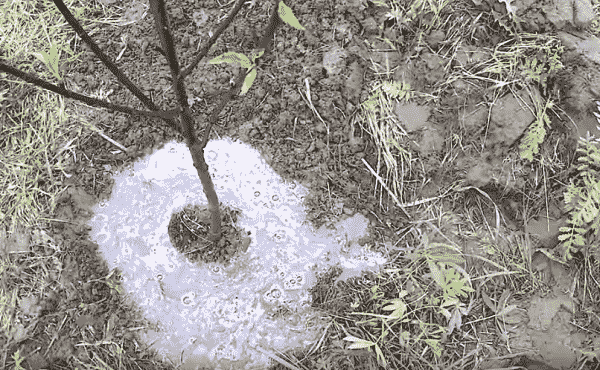

After that, add earth, lightly tamp it with your foot, and then mulch with rotted manure.
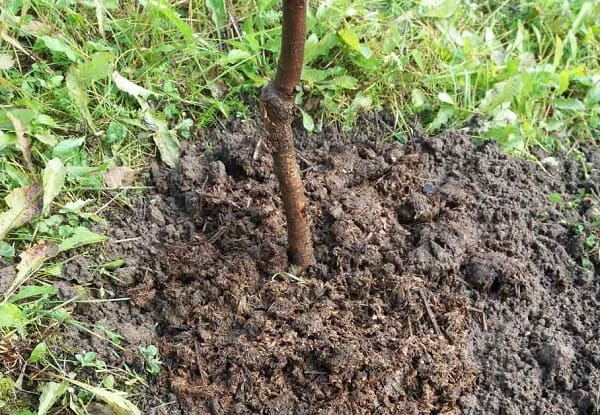

Experienced gardening tips
When planting in the fall, experienced summer residents recommend choosing a permanent place for the cherry and not planting it in temporary areas with the prospect of subsequent transfer. Transplants injure the cherry, which has already taken root in the ground, so it is better to plant the tree where it will spend the next 15-20 years of its life.
The pit for the autumn planting needs to be prepared not at the last moment, but in advance.If you dig a hole and immediately lower a seedling into it, then soon the soil will naturally settle, and with it the tree. When preparing the pit, 2-3 weeks before planting the cherries, the soil has time to sink, so there is no need to face troubles after planting.
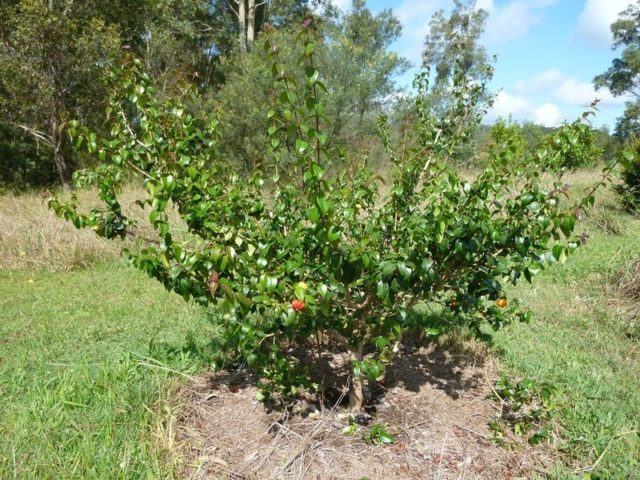

In autumn, when planting in a hole, fertilizers with nitrogen must not be laid.
Fertilizing for cherries in the fall must be applied - fertilized soil helps the plant to take root faster. But at the same time, only potash and phosphorus fertilizers need to be poured into the soil. Nitrogen fertilizers and organics with a high nitrogen content should be postponed until spring. Otherwise, it will be more difficult for the plant to leave for wintering in time, nitrogen will provoke late sap flow, and with the onset of frost, the tree will suffer.
For autumn planting, it is recommended to purchase high-quality and healthy seedlings from trusted manufacturers, especially since prices for planting material usually fall in the fall. Too cheap plants of unknown origin may not have the required cold resistance characteristics and simply die from frost.
Step-by-step instructions for planting in the fall
The autumn planting of cherries is not much different from the same event held in the spring. However, there are still some features that should be discussed in more detail.
How to choose the best seedling
Most of the cherry varieties are self-fertile, therefore, for normal pollination, you should purchase several trees, at least three different varieties.
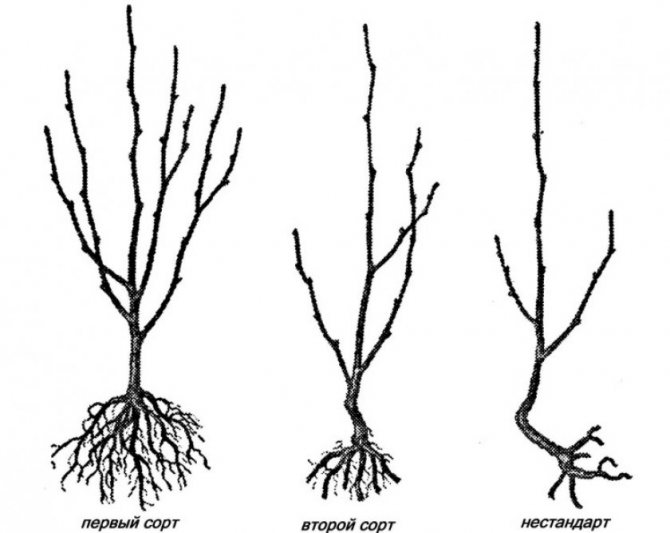

Healthy and high-quality planting material is the key to a good harvest.
When choosing planting material, you need to focus on the following characteristics:
- it is better to take a one-year, in extreme cases - a two-year sapling (the growth of the first should be about 0.7–0.8 m, the second - about 40–50 cm more);
- there should be no visible damage on the seedling;
- the roots should be fairly developed, look healthy, have no breaks, be 24–26 cm or more in length.
If the growth of the tree noticeably exceeds the indicated dimensions, this is most likely indicative of excessive nitrogen fertilization, which has a very bad effect on resistance to cold. Such seedlings can be planted only in spring, otherwise they are unlikely to overwinter.
Both in nurseries and at private owners, you can find grafted and self-rooted plants. The grafted tree begins to bear fruit earlier, but the rooted tree tolerates the cold better, more varieties and species are suitable for them for reproduction. It should also be borne in mind that with the joint planting of self-fertile varieties, their yield will increase significantly.
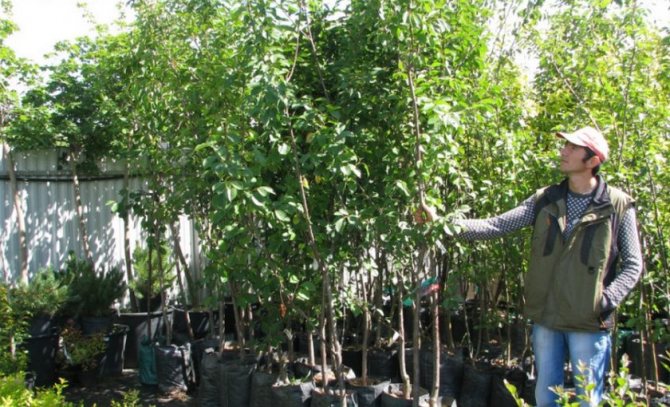

How to choose the right landing site
A rooted adult tree reacts extremely negatively to transplanting, so the place must be chosen based on the lifespan of a cherry: a bushy one can live 16-18 years, a tree-like one - up to 22-24 years. The most favorable place for growing cherries is on a small hill, well heated by the sun, sheltered from the northern winds. Alternatively, a sloping slope extending to the south or southwest. Groundwater should be no closer than 1.7 m from the surface of the earth.
Read also Features of the structure of the mycelium under a small microscope magnification
What soil is suitable for cherries and how to prepare the site
The most suitable type of substrate is clay or sandy fertile soils with a pH of 6.0-7.0. In acidic peaty soils, you will have to remove the top layer by at least 20 cm and replace it with a fertile substrate. Weeds represent a rather serious competition for the roots of the tree, therefore, when preparing a site for planting, the earth will need to be dug up 2-3 times, removing all residues of plant origin.
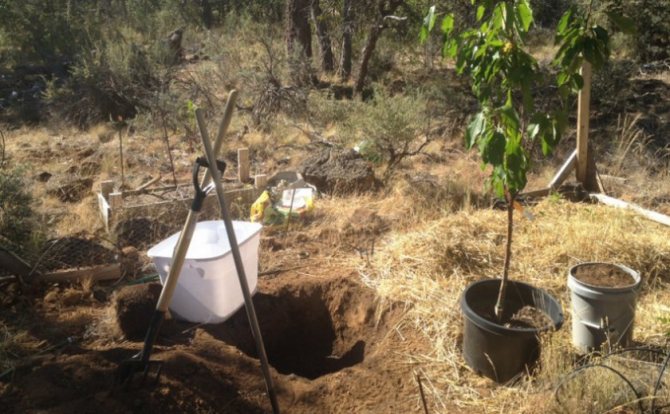

Preparing the landing site.
During digging, the following fertilizers are introduced into the ground (per 1 m²):
- manure or compost - 1 bucket;
- superphosphate - 3.5 tbsp. l .;
- potassium salt - 1.5 tbsp. l.
What depth to plant
The wells for planting are prepared 2-3 weeks before the expected date of the procedure.If you are planting bushy varieties, dig holes according to the 2 × 2 m scheme; for tree varieties, adhere to the location 3.5 × 3.5 m. The hole is dug 0.5 m deep.If the hole has a round shape, its approximate radius is about 0, 55–0.6 m. For a hole with a shape close to a rectangle, the approximate size is 0.5 × 0.5 m. When digging a hole, set aside the top layer (20–25 cm) separately, it will be part of the mixture for filling the hole.
For this mixture, take the following components:
- topsoil - 1 bucket;
- humus - 1 bucket;
- potassium sulfate - 2 tbsp. l .;
- superphosphate - 12 tbsp. l.
All components are well mixed, and if the soil is heavy, then it is mixed with river sand (1: 1). The bottom of the hole is laid out with expanded clay drainage, onto which the finished soil mixture is poured to 1/3 of the depth of the hole.
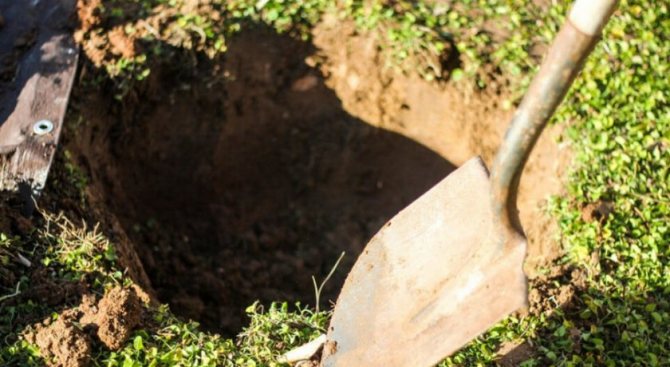

Planting seedlings
Before planting a tree in the ground, carefully examine it. Remove all damaged parts of the root system and foliage, which the plant does not need at this stage, since moisture leaves through it. If the root system looks too dry, the seedling is placed in water for 11-14 hours, so that the liquid reaches the root collar. If there are traces of drying on the trunk, the tree is placed in water for a third of its length.
You can use a solution of the biostimulator "Heteroauxin" instead of water - this will significantly increase the survival rate of the tree. Moreover, treatment with a stimulant will not hurt in any case, even if the seedling looks very healthy and strong.
When all the preliminary work has been done, you can proceed directly to planting the seedling:
- Drive a wooden stake (200x30x30 cm) into the bottom of the hole, north of the center.
- At the bottom, build a small mound from the mixture prepared in advance. Its height should be such that after filling the hole, the root collar is 4–6 cm above ground level.
- Install the tree, align its roots along the embankment.
- Fill the hole with soil mixture, periodically tamping it.
- Tie the barrel to the peg with strips of soft cloth.
- Pour warm water over the tree (2-3 buckets per seedling).
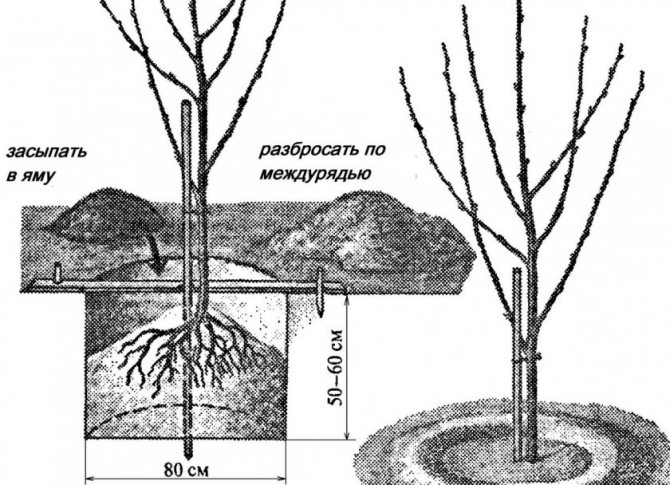

Cherry planting scheme.
Diseases and pests
| Coccomycosis Symptoms:
Treatment:
|
| Moniliosis Symptoms:
Treatment:
|
| Cherry weevil Symptoms:
Treatment:
|

